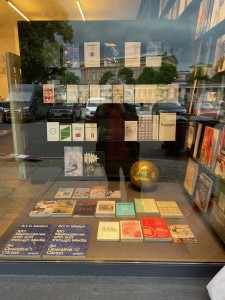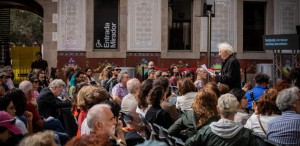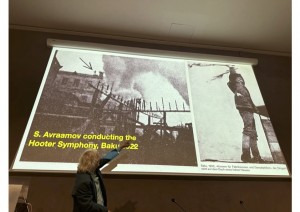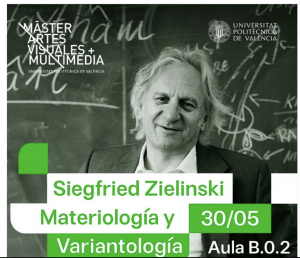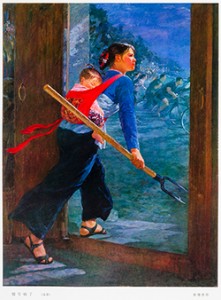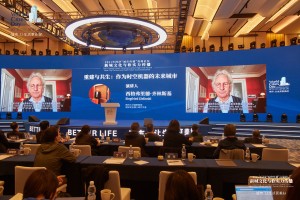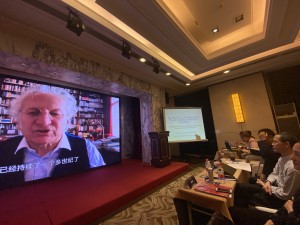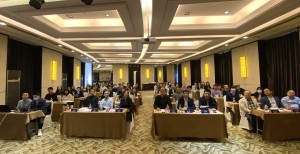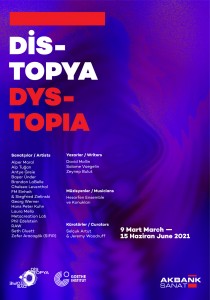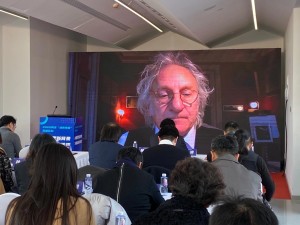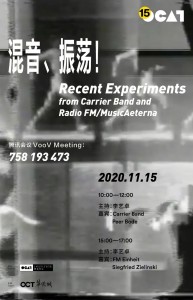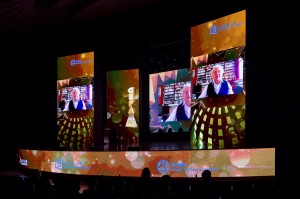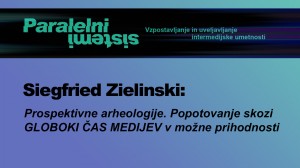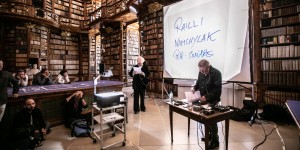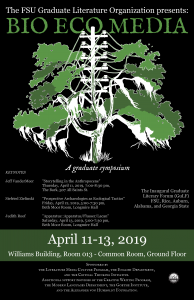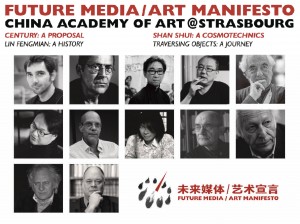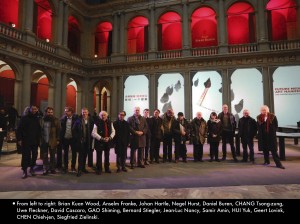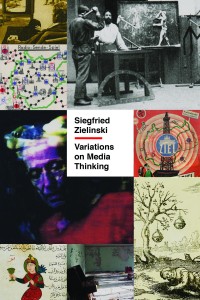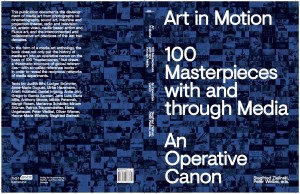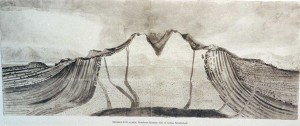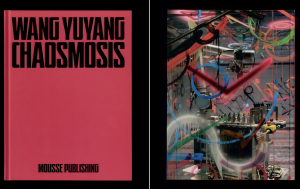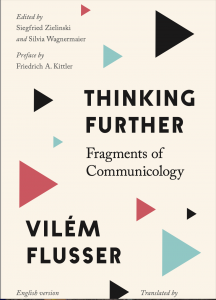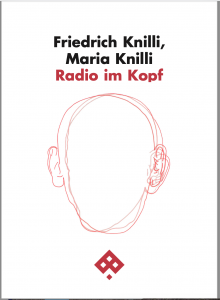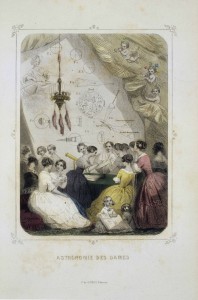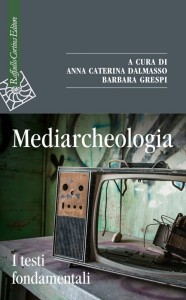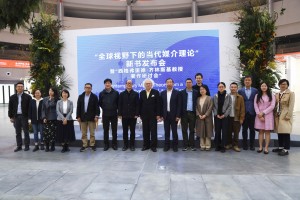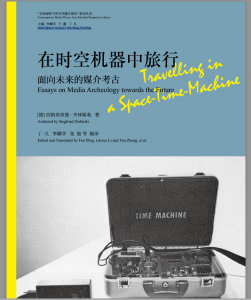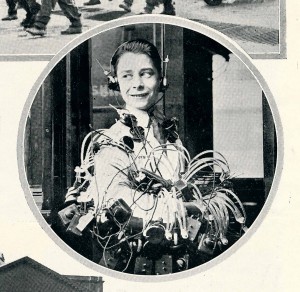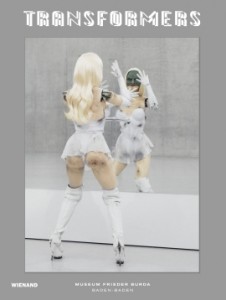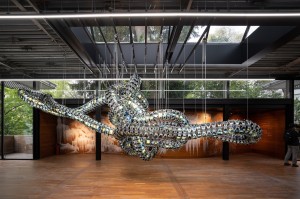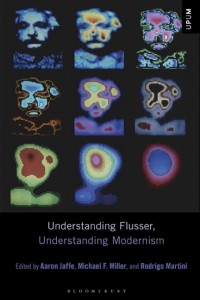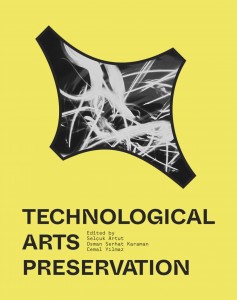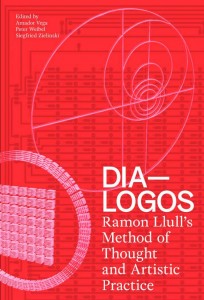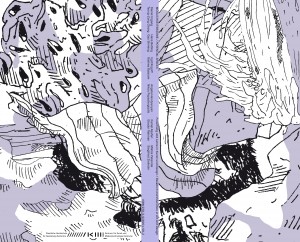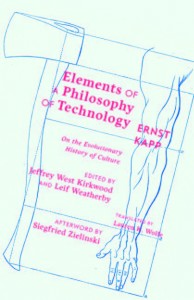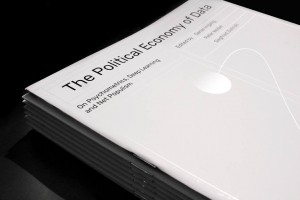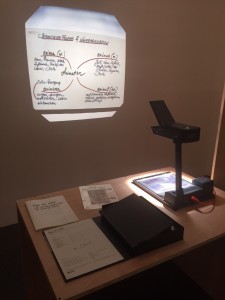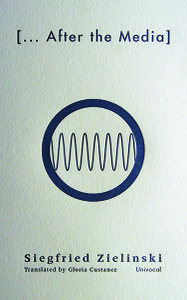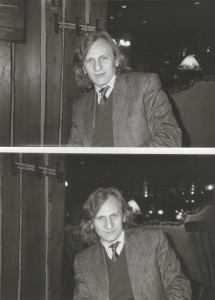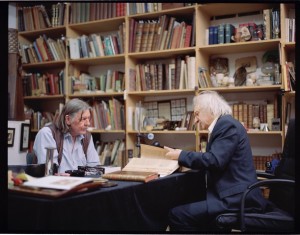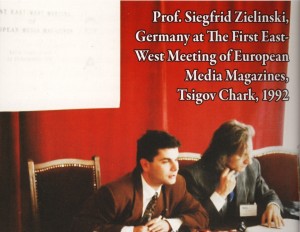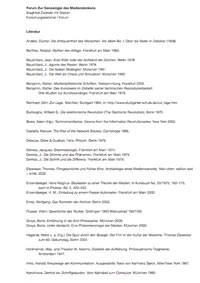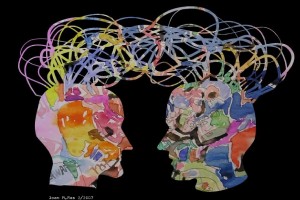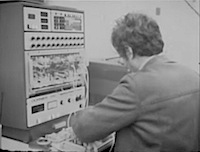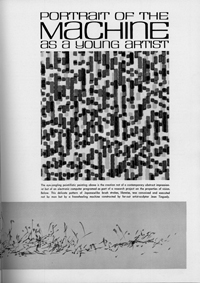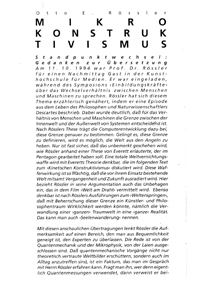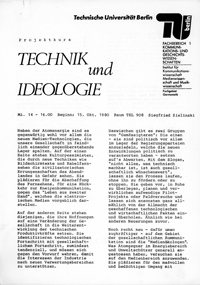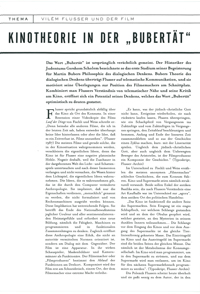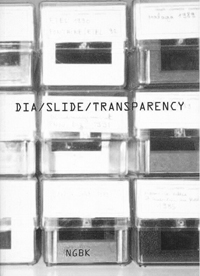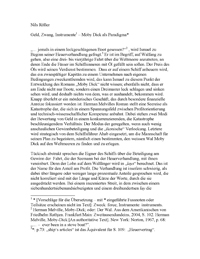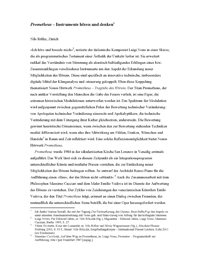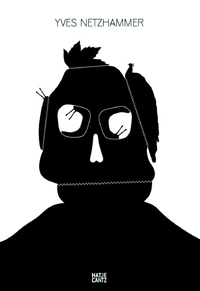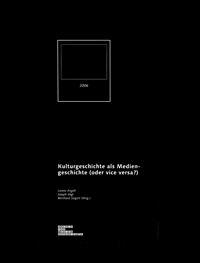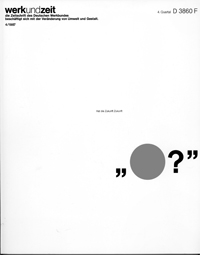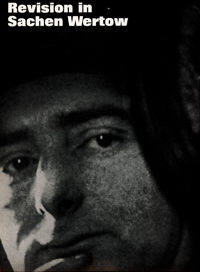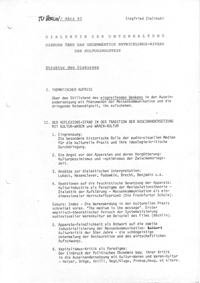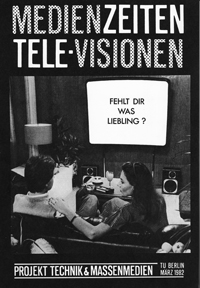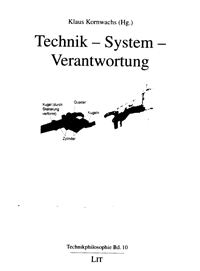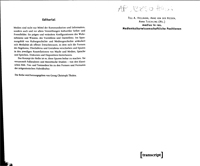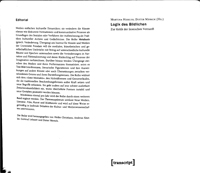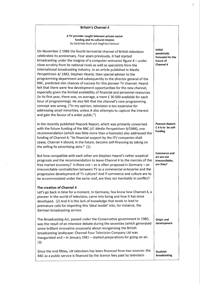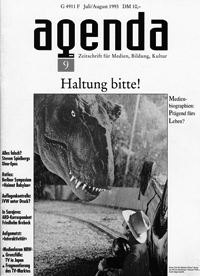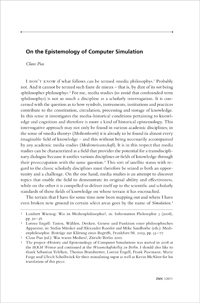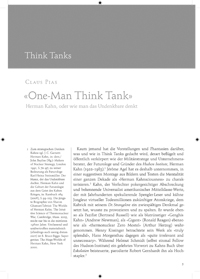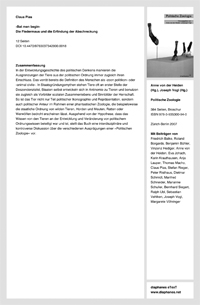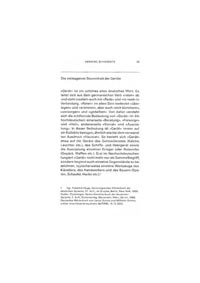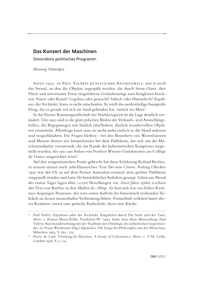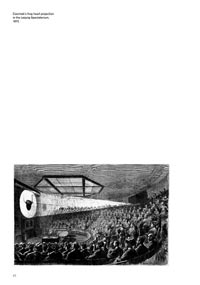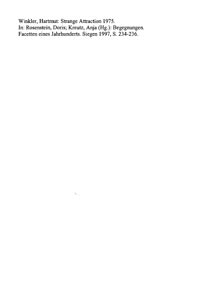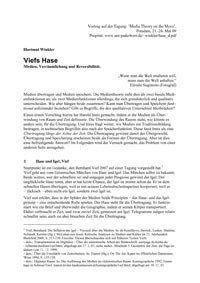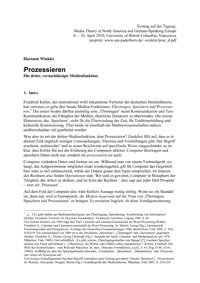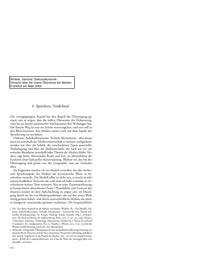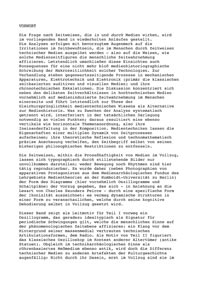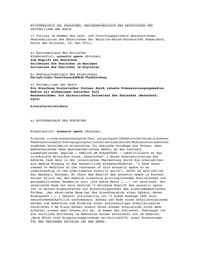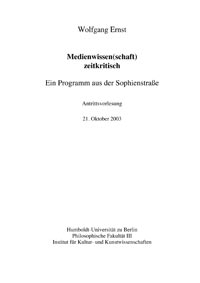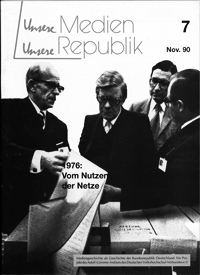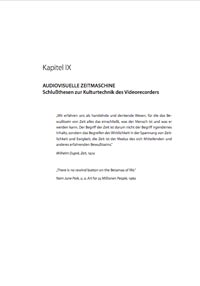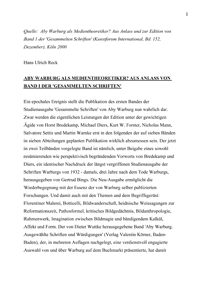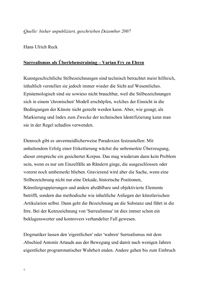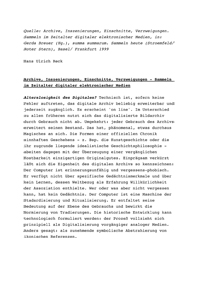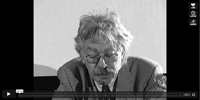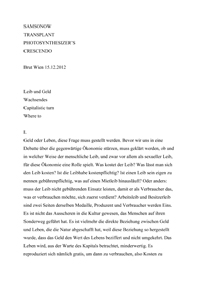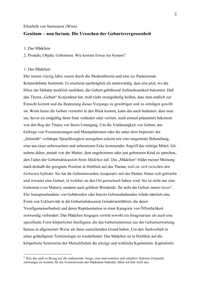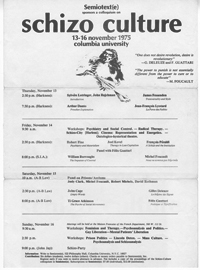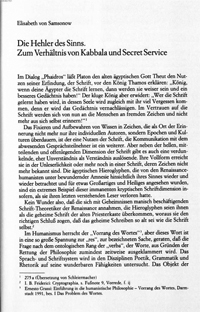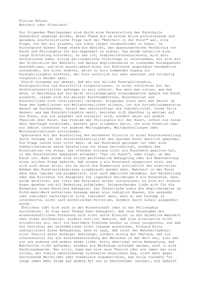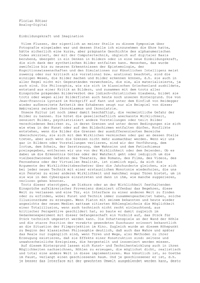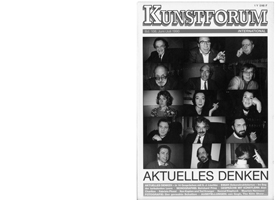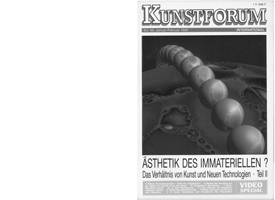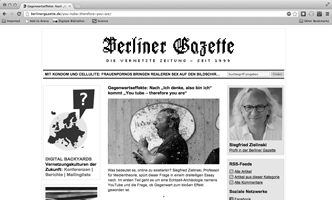video (youtube)
Otto Roessler, Chaos, Spiral Chaos, Screw Chaos, Double Spiral Chaos, Hyperchaos. (Madison, 1976 and Toulouse, 1979).
Siegfried Zielinski
Professor emerit. for Archaeology & Variantology of the Arts & Media at Berlin University of Arts;
Michel-Foucault-Professor for Techno-Aesthetics and Media Archaeology at EGS Saas Fee (CH);
Guest Professor at Tongji University in Shanghai;
Prof. h.c., Dr. h.c. Budapest University of Arts.
contact: majaneu@gmx.de
Dates
Fryday 21-11-2025, 7 pm Buchhandlung König
Artificial Extelligence – A Short Manifesto
Reading (in German) and discussion with
Artists Press (Tom Fecht) und Christian Posthofen
Burgstr. 27, 10178 Berlin
Fryday 28-11-2025 7 pm at ARTISTs PRESS
on the occasion of the finissage THE BEAUTY OF CHANCE
The Guest Room Dresdener Str. 10, 10999 Berlin
7 November 2025, TU Berlin, Main building, Room H2036
Podium: “Anders Forschen und Lehren an der TU Berlin der 1970er und 1980er Jahre”
(in German)
Möglichkeiten_einer_Insel_Workshop
8 October 2025, Berlinische Galerie (7:30 pm)
Catalogue Raisonné Publication
Podium for Chan Sook Choi’s new catalogue:
“The Non-Statistical Body”
mit Sooyon Lee, Jesi Khadivi, Young Bin Kwak
Distanz Verlag Berlin
26 June 2025, 7 pm , Berlin, Burgstraße
Buchhandlung Franz and Walther König
presentation of the book-catalog ART IN MOTION
and colloquium with authors, designers, ZKM, publisher
moderated by Christian Posthofen
May 13, 2025 Arles/France
École nationale supérieure de la photographie
Lecture Re-Visiting Vilém Flussers Philosophy of Photography
(including a Manifesto on Artificial Extelligences)
Symposium “Playing Against the Apparatus – Flusser et l’art”
April 24, 2025 Museum of Modern Arts Bologna
Clandestine Talks – A project by Lara Favaretto
Thinking Head: PARADOX
April 23, 2025 University of Bologna, Dept. of Philosophy
Lecture Materiology & Variantology – Some Remarks
Host: Diego Donna
DiegoDonna_PoliticsTechnology_A3
October 31, 2024, Universität der Künste Berlin
Vortrag und Diskussion:
Freedom is not just another word for nothing left to loose
Colloquiumsleitung: Gesche Joost
October 13, 2024, CCCB (Barcelona)
Dancing Philosophy - A Dialogue in Music and Speech
with Anthony Moore and Siegfried Zielinski
May 29/30, 2024 IVAM and Polytech
University Valencia (Spain)
Lecture/symposium on the art of Llorenç Barber
Foto: Lorenzo Sandoval
April 13, 2024 Karlsruhe ZKM (Centre for Art and Media)
Radio Free Modulations / Was kostet den Kopf?
Performance and discussion of new radio pieces by FM Einheit and Siegfried Zielinski
Foto: ZKM
April 28, 2024, Schloss (Castle) Wahn, Cologne
Opening speach for a symposium in honour of Werner Nekes’ 80th birthday
Followed by a two day symposium organized by the department for theatre at Cologne University
November 7-8, 2023 Shanghai, ZhangJiang High-tech Park
Keynote for the conference
Counter-Culture? Resetting all (im)possibilities of Technology
organised by the Institute of Network Society School of Inter-Media Art
(China Academy of Art, Hangzhou)
November 9-10, 2023 Tongji University Shanghai
Worshop with professors and researchers,
presentation of my new book on Mandarin
“Travelling in a Time Machine”, published by
Tongji University Press, Shanghai
October 2023, Tongji University
MATERIOLOGY & VARIANTOLOGY
Principles of thinking media and arts
in times of crises and radical upheavals
Video Lecture at the
Academic Forum Media Culture 2023
1 July, 2023 E-Werk Luckenwalde
Art station in Brandenburg
BURN OUT – Concert with FM Einheit & Band, with Rica Blunck
(Performance of songs SZ has written for FME)
May 31, 2023, Istanbul
Variantology & Travelling in a Time Machine –
The Work of Art in the Age of its Infinite
(Re)Producibility and Perceivability
Lecture at the Sabanci Museum
May 25, 2023, Dortmund
Presentation of the youngest radio pieces by FME & SZ
in the cinema U, invited by Marcel Marburger & Oliver Schwabe
March 26, 2023 ZKM Karlsruhe
Automata and Experimental Culture in the Early, Arabic-Islamic, Renaissance
Lecture for the Symposium on the Third Renaissance, organized by Peter Weibel
and the ZKM, Karlsruhe March 24-26
17.02.23 at 7:30 p.m. Berlin
An evening of sonic interception with FM Einheit & Siegfried Zielinski
im Club der Polnischen Versager, Ackerstrasse 169 10115 Berlin
Hosted by Aneta Panek
An artistic exchange between musician F.M. Einheit and media archaeologist Siegfried Zielinski span- ned two years, resulting in a critical and sonorous jumble of ideas – sometimes topical, sometimes
phantasmagorical, sometimes sound poetry.
“Art is resistance. There is no art without waste,” says Siegfried Zielinski. The researcher has been
studying media archaeologies and the function of archives for years. “Matter is active. It is subject, not object.”
Zielinski and the sound explorer F.M. Einheit accessed their “an archives” for Free Modulations Radio. The sounds they found inside were left to run rampant. A mental drift of quotations from Vilém Flusser to Genesis P-Orridge. Poetry of an artificial intelligence. The virus. The time. The apparatus. A montage of attractions.
With text fragments and voices from Antonin Artaud, Meret Becker, Walter Benjamin, Benjamin Bratton, William S. Burroughs, John Cage, Teodor Currentzis, F.M. Einheit, Vilém Flusser, Alexander Galloway, Alexander Hacke, Volker Kamp, Saskia von Klitzing, Georg Christoph Lichtenberg, David Link, Jennifer Minetti, Phil Minton, Alexander Moissi, Heiner Müller, Genesis P-Orridge, John Peel, Michael Saup, Henning Schmidgen, Werner Schwab and Siegfried Zielinski.
Production: Deutschlandfunk Kultur, “Klangkunst” (Marcus Gammel).
15 October 2022
Opening keynote for the 2022 Chinese Applied Journalism and Communication Forum
College of Arts and Media Tongji University of Shanghai
21 September, 2022
Jury International Film Festival Hong Kong
for best experimental films by students
Zuerich 8 June, 2022
becoming disposable -
towards an open operational concept of media.
Opening keynote speech for the conference
format : dispositif
format dispositif symposium program
*****
Copenhagen 6-8 April, 2022
“From the Unconditional ME to the Unconditioned WE”
conference Connect/Cut. Infrastructures and Collective Activity
Final_Program_Cut_Connect_2022
***
Shanghai Oct 30, 2021
Lecture: Some Short Reflections on
the City as a Space-Time-Machine
Conference New city:
Cultural Communication and Soft Power
Forum Tongji University
https://mp.weixin.qq.com/s/jMrZPxHfkEZJH20O9CW9Pw
Oct 29, 2021, ZKM Karlsruhe
Art Institutions in the Age of Existential Risks –
International Conference on the Future of Museums
Vortrag über Kunst-Institutionen
der Zukunft als “Surprise Generators”
https://zkm.de/de/veranstaltung/2021/10/art-institutions-in-the-age-of-existential-risks-what-to-do
October 28, 2021, Shanghai
(virtual lecture):
New Perspectives in Genealogy of Media Thinking Variantology & Prospective Archaeology
Annual Meeting of the Academy on the History of Communication Thoughts
Tongji University, Shanghai October 28/29, 2021
October 29, 2021, ZKM Karlsruhe
Art Institutions in the Age of Existential Risks –
International Conference on the Future of Museums
Lecture on “Surprise Generators”
https://zkm.de/de/veranstaltung/2021/10/art-institutions-in-the-age-of-existential-risks-what-to-do
October 17, 2021, Hamburg/Kunsthalle
Laudatio for Agnes Meyer-Brandis
Winner of the Kairos Award /Alfred Toepfer Foundation
August 8, 2021, Berlin
Siegfried Zielinski, Franziska Latell, Aneta Panek, Margit Rosen
Prospektive Archäologie vs. Globale Synchronisierung/Prospective Archaeology vs. Global Synchronisation
Podium at the Berlin Academy of Arts, Pariser Platz
Museums and archives are essentially time machines. Media thinker and archaeologist Siegfried Zielinski discusses the dystopia of a globally synchronised present and explores with his guests how (an)archives, collections and expositions can be related to each other as generators of surprise.
July 8/9 2021, Hamburg (no-place Zoom)
Die Kraft der Einbildung: Physiologie, Ästhetik, Medien
Workshop der Kolleg-Forschungsgruppe »Imaginarien der Kraft«
Lecture and dialogue – with Daniel Irrgang
May 5, 2021 – Kunsthochschule Dresden
in coop. with the Dresden Art Academy
Lecture “Operative Kanonisierung”
in den Künsten der Gegenwart (in German)
(verschoben)
March 9 – June 15, 2021, Istanbul
Exhibiting “Voices” from 22 episodes
of Radio FM – with FM Einheit
Dec 12, 2020, Shanghai
Forum at West Bund Art Centre Shanghai
Theme: Freedom & Control in Arts & Design (Education)
Place: West Bund Art Center Hall A (No. 2555 Longteng Avenue)
Online forum via Zoom and onsite
Chaired by Professor Xing Ruan and S. Zielinski
talks by Kristoffer Gansing, Andrès Burbano, Matteo Pasquinelli and David Link
Comments and Questions:
Prof. Xing Ruan and Dean Ilaria Valente (Turino)
*****
December 12, 2020, Shanghai
Tongji University – International Forum on Urban Communication
Video-Lecture:
Heterotopic Places – The City as a Stage
or: Materialism of Encounters
*****
Nov 15, 2020, Beijing
OCAT-Festival Beijing
Broadcasting of VIRUS – episode #2 of the acoustic series on MusicAeterna,
St. Petersburg. Additionally FME and SZ are present in Video & Audio:
https://mp.weixin.qq.com/s/bMznea9kA5nN019KHu9V5Q
Nov 6-7, 2020 – Nam June Paik Art Center Seoul
Living in the Postdigital, Reliving the Museum
Keynote Lecture on Paik and the museum of the future
(text contribution) and audiovisual statement
(offline lecture postponed to 2021)
Nov 4-6, 2020 – International Film School Hong Kong
Global Film Award for Film Schools
Jury for experimental film, Award presenter
Master Class for Students of the IFS Hong Kong
on Expanded Animation postponed to spring 2021
October 02-04, 2020 – Lviv, Ukraine
“The Shy Machines” – The Futurological Congresswhich
Keynote (postponed)
September 4, 2020, Berlin
Opening of the exhibition IN ABSENTIA at
KUNSTHALLE KOIDL Berlin-Charlottenburg
cur. by Walter Lenertz
Dieter Appelt, The Brothers Quay, FM Einheit,
Walter Lenertz, Wolfgang Petrick, Rebecca Raue,
Peter Weibel, Siegfried Zielinski, Thomas Zipp
July 25 – 31, 2020 – Bergamo Art University
Summer classes for the European Graduate School
on Variations on Media Thinking
(Together with Slavoj Zizek)
Will take place as a telematic seminar!
July 10-12, 2020 – Eindhoven, ICOHTEC
International Committee for the History of Technology (UNESCO)
Summer School Seminar
(postponed)
May 11, 2020 – UCLA, Los Angeles
Symposium/book presentation:
Art for the 21st Century – Provocations and Reflections
with Masaki Fujihata, hosted by Erkki Huhtamo and osage Hong Kong)
April 19, 2020 – Schauspielhaus Hamburg
Laudatio auf die Künstlerin Agnes Meyer-Brandis
Europäischer Kulturpreis KAIROS der Toepfer Stiftung
(cancelled/postponed)
April 3 – Baptiste University Hong Kong
Jury and Presenter for the Global Award for Student Films
April 2 – International Film School Hong Kong
Masterclass on Expanded Animation
(postponed to Nov 4-6, 2020)
Feb 20 – March 20, 2020, Beijing
(postponed!)
Art in Motion – 100 Master Pieces With & Through Media – An Operational Canon,
curated by Peter Weibel and Siegfried Zielinski for the ZKM Karlsruhe in 2017/18, will be exhibited in a different format in the framework of CAFAM Techne Triennial, directed by ZHANG GA (张尕) for the CAFA Art Museum in Bejing.
CAFA Art Museum, Beijing, China www.cafamuseum.org/en/
Dec 13, 2019 – Istanbul
Keynote on Preservation of Techno-beased Arts
Conference at Sabanci Museum Istanbul (hosted by Sabanci Museum and University, Selcuk Artut, Faculty Arts & Design)
Dec 10, 2019 - Ljubljana
Torek, 10. december 2019, 18.00
Moderna galerija, Cankarjeva 15, Ljubljana
Lecture on PRO-SPECTIVE ARCHAEOLOGIES. Travelling through DEEP TIME OF THE MEDIA – from the Past to the Future.
http://www.scca-ljubljana.si/siegfried-zielinski-prospektivne-arheologije/
Dec 2-3, 2019 – Beijing
Media Archaeologies – A 2 days conference at Peking University (School of Fine Arts) with Thomas Elsaesser and Siegfried Zielinski
The symposium includes the screening of an early project on experimental archaeology of the media, which Siegfried Zielinski had produced in 1992 at the University of Salzburg (with Alois Pluschkowitz):
100 – 20 Short Films Towards an Archaeology of Audiovisions
Nov 29, 2019 – Tongji University of Shanghai
Evening Lecture on Pro-Spective Archaeologies
Poster: Nikita Lin
Nov 26-27, 2019 - Shanghai
Non-trivial Relations Between Arts and Sciences.
A 2-day Forum organised by the Shanghai Art School at Westbund, initiated and directed by Siegfried Zielinski as part of the FutureLab Shaghai – on world wide developments of Academies/Universities for Art and Design
Credit: vog.photo
Anthony Moore (UK/FR), Siegfried Zielinski (DE)
Walking Lectures: Calculated Sensation
Ars Electronica Linz, 2019
Earlier in 2019 Siegfried Zielinski presented his variations on media thinking in lectures, seminars, colloquia in Abu Dhabi, Austin (US), Berlin, Frankfurt/Main, Hong Kong, Houston (US), Karlsruhe, Lausanne (CH), Linz (A), Saas Fee (CH), San Marco (US), Shanghai, Shenzhen, Talahassee (Florida), Teheran, Washington and Zagreb.
Strassbourg 2018 : Manifesto conference:
*****
Lecture at the Central Academy of Fine Arts, Beijing
*****
For the many activities and events between 2015 and 2018,
please, see the websites f.e. of the Berlin University of Arts
and the Karlsruhe University of Arts & Design (HfG)
Past Events within the forum on genealogy of MediaThinking:
24.10.12
Prof. Dr. Peter Weibel Vienna / Karlsruhe
Media theorist, artist, curator, director of ZKM Karlsruhe
Link to Prof. Dr. Peter Weibel’s Biography
07.11.12
Prof. Dr. Joachim Paech Konstanz / Berlin
Media and film theorist
Website of Prof. Dr. Joachim Paech
21.11.12
Prof. Dr. Thomas Elsaesser Berlin / London / Amsterdam
Film and media critic, historian and theorist, co-founder of the Amsterdam School of Cultural Analysis (ASCA)
Website of Amsterdam University
05.12.12
Florian Rötzer Munich / Telepolis
Art critic, writer, artist, editor
Articles by Florian Rötzer on heise.de
A portrait by »tagesspiegel«
16.01.13
Prof. Dr. Elisabeth von Samsonow Vienna
Philosopher, artist, media researcher
Website of the Academy of Fine Arts Vienna
30.01.13
Prof. Dr. Hans-Ulrich Reck Basel / Cologne
Art historian, philosopher and media theorist, curator
Website of the Academy of Media Arts Cologne
13.02.13
Prof. Dr. Boris Groys New York
Art and media theorist, curator, cultural philosopher
Website of HFG Karlsruhe
Website of New York University
25.04.13
Prof. Dr. Hans Belting Karlsruhe / Berlin
Art and media theorist, art historian, curator
Bibliography of Hans Belting on the ZKM website
Hans Belting’s biography on GAM – Global Art and the Museum
02.05.13
Prof. Dr. Wolfgang Ernst Berlin
Media theorist, archaeologist, archive theorist
Website of Humboldt-University Berlin
16.05.13
Prof. Dr. Hartmut Winkler Paderborn
Media theorist
Website of Paderborn University
30.05.13
Prof. Dr. Henning Schmidgen Regensburg
Historian of science and technology, Professor for media aesthetics; time machine specialist
Website of Regensburg University
13.06.13
Prof. Dr. Claus Pias Lüneburg
Media theorist, philosopher of the digital; cybernetics specialist
Website of Leuphana University
04.07.13
Prof. Dr. Sybille Kraemer Berlin
Philosopher – with focus on phenomena of media and communication
Website of the Free University Berlin
18.12.13
Prof. Dr. Nils Röller Zurich
Professor for Media- and Culture theory at the HGKZ (Academy for Design and Art) Zurich
Website of the Institute for Contemporary Art Research
Website of the Journal für Kunst, Sex und Mathematik
15.01.14
Prof. Dr. Knut Ebeling Berlin
Professor for media theory and aesthetics at the Berlin Weissensee School of Art
Website of Berlin Weissensee School of Art
08.05.14, 6-8 pm
Prof. Dr. h.c. VALIE EXPORT Vienna
Artist
Website of VALIE EXPORT
02.07.14, 7-9 pm
Geert Lovink Amsterdam
Media theorist and activist
institute of network cultures
09.07.14, 7-9 pm
Prof. Dr. Otto Rössler Tübingen
Chaos theorist, biochemist, endophysicist
excerpt from “Variantology: Einstein Bohr Battle Confirms Everett’s Eternal Now”
The Forum on the Genealogy of MedieaThinking essentially lived through the contributions of the many students at the University of the Arts Berlin, who participated in the project.
For their contributions as authors, photographers and designers as well as for the technical support, sound recordings and transcription of the panels, we would like to thank: Anna Beykirch, Noemi Cipollone, Gerald Dissen, Julia Ebert, Marius Förster, Konstantin Daniel Haensch, Maria Meermeier, Inger Neick, Maria-Elisabeth Niebius, Katharina Papke, Mathias Paul, Kristina Paustian, Sebastian Prassek, Robert Preusse, Stefanie Rau, Julia Schmidt and Eva Zahneißen, as well as Anita Ackermann, Steve Bergmann, Philip Bresinsky, Elisa Storelli and Philipp Tögel.
Variations on Media Thinking
Published as vol. 52 of the Posthumanities series ed. by Cary Wolfe
(Minneapolis: University of Minnesota Press, 2019)
Review of SZ’s Variations on Media Thinking – symploke 2020
http://neural.it/2021/04/siegfried-zielinski-variations-on-media-thinking/
Expanding on Siegfried Zielinski’s groundbreaking inquiry into “deep time” of the media, these essays foster the eminent media theorist’s unique method of expanded hermeneutics, which means for him interpreting technical artifacts as essential parts of our cultural lives. Including many previously untranslated and scarce essays, these “written time machines” further diversify Zielinski’s insight into the hidden layers of media development.
The oldest essay, which has been translated for this book, has been written in a first version in 1975. Its topic is the Worker’s Radio Movement (Arbeiter-Radio-Bewegung) in the Weimar Republic, to which one can refer as the first Hacker’s movement in the 20th century. In the German original it was only published in the first two editions of the catalogue >>Wem gehört die Welt?<< (Who Owns the World?), for the following editions it suffered censorship and was not included anymore. – The latest text is Allah’s Automata, written for the exhibition with the same title, hosted by the Centre for Art and Media Karlsruhe (ZKM) in 2015.
Historians of technology know that any tool is also an instrument of exploration, experiment, and simulation. Siegfried Zielinski reminds us that any technology is also a generator of wonder. In fact, Zielinski does not write media history, he writes world history through the generative lens of media as machines of speculation and imagination. This is a material history of dissent, heretical hermeneutics, and electrified alchemic curiosity.
(Matteo Pasquinelli)
***
+++++
Wang Yuyang: Chaosmosis
Texts by Rudolf Frieling, Mark B. N. Hansen, Caroline A. Jones, Zhang Ga, Siegfried Zielinski
Selection of texts from what in German is called
Bochumer Vorlesungen – Kommunikologie weiter denken.
Publication planned for January 2026
Minnesota University Press
VIENNA, Passagen 2025
Mit einem Essay von Siegfried Zielinski:
“Friedrich Knilli – Medienpionier,
Überraschungsgenerator, Anarchist, Unternehmer”
Zeichnungen: Lena Knilli
Amador Vega
Dendrites and some fundamental questions. A conversation between Juliane Henrich, Siegfried Zielinski, and GPT-4 about Novalius and a video installation. In: Resonant Spaces/Resonanzräume, Katalog, Wiesbaden: Nassauischer Kunstverein, English 2025, German 2023, 24-39
in a modified variation printed as:
Juliane Henrich, Siegfried Zielinski, with GPT-4, and Friedrich von
Hardenberg aka Novalis
Crystallographic Resonances: Rewriting Novalis
In: Technology and Language #122, Future Writing
Peter the Great St. Petersburg Polytechnic University
***
http://openthresholds.org/howtonavigate
https://lareviewofbooks.org/article/unabashed-tour-dhorizon-media-20th-century/
***
Radio Boy in a British train (ca 1930)
New cooperations with FM Einheit:
RADIO FREIE MODULATIONEN -Radio Art for
Deutschlandfunk, the central German radio station:
https://www.hoerspielundfeature.de/radio-freie-modulationen-100.html
“Was kostet den Kopf? – Eine Ringschaltung”
Radio Art – ReVisiting the so called first Russian Avantgarde
https://www.ardaudiothek.de/episode/swr2-hoerspiel/fm-einheit-und-siegfried-zielinski-
was-kostet-den-kopf-eine-ringschaltung/swr/12686489/
*****
FM module/ on MusicAeterna,
Teodor Currentzis’ platform as part
of an artist in residence program
in St. Petersburg
Together with FM Einheit’s large network of artists like Andreas Ammer, Alexander Hacke, David Link, Genesis P-Orridge, Caspar Broetzmann, Mona Mur, Katharina Franke, Stuckie and many others FM Einheit and Siegfried Zielinski develop in this project an unusual acoustic format. Between Ars Acoustica, radio play, acoustic Lehrstück, Schallspiel, poetry, our living archives and philosophical thought, a cosmos of sensual-reflexive experience is created – exclusively for listening. 25 programs have been created until the cooperation was stopped because of Putin’s aggressive war against the Ukraine:
https://musicaeterna.world/en/?id=363 https://www.youtube.com/watch?v=K_keSV279PA – VIRUS https://musicaeterna.world/en/?id=369 https://musicaeterna.org/en/?id=372 https://musicaeterna.org/en/media/fm_5_resistance/
https://musicaeterna.org/en/media/fm_6_silence_tracks_/
https://musicaeterna.org/en/media/fm_7_time/
https://musicaeterna.org/en/media/fm_9_schnittstelle_interface_1/ https://musicaeterna.org/en/media/fm_10_schnittstelle_interface_2/ https://musicaeterna.org/en/media/fm_11_ocean/ https://musicaeterna.org/media/fm_modul_14_prikosnovenie/ https://www.youtube.com/watch?v=e9rLxufUew4 https://musicaeterna.org/en/media/fm_module_17_freedom/ https://www.youtube.com/watch?v=HcoM7aJA9UY – (skin) https://soundcloud.com/radio_musicaeterna/fm-module-21 https://www.youtube.com/watch?v=LXvMehtHqq8 https://www.youtube.com/watch?v=2yXIo2hDTIM https://www.youtube.com/watch?v=9uTMWaH89ps
***
“Frivolous Beings – When Artifacts Become Subjects”
Essay in Udo Kittelmann’s exhibition catalogue TRANSFORMERS for Museum Frieder Burda, Wienand 2023
*****
“Between Res Cogitans and Res Extensae -
A Short Portrait of the Artist Yunchul Kim”
Essay im Ausstellungskatalog des Künstlers Yunchul Kim, der 2022
den koreanischen Pavillonauf der Biennale von Venedig bespielt hat.
***
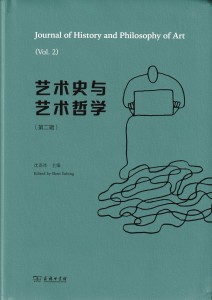
The Journal of History and Philosophy of Art at Fudan University in Shanghai publishes some of the lectures from the symposium POESIS AND PRECISION, which Siegfried Zielinski curated in 2019, including my text on Art and Science as Practised Culture of Experiment.
Editor of the Journal (Vol. 2) is Shen Yubing from Fudan University 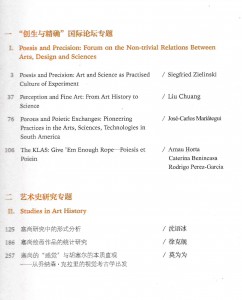
*****
In honor of artist Yunchul Kim’s exhibition in the Korean Pavillon at the 2022 Venezia Berlinale a large catalogue has been published by Hwasun L. Barakat in Seoul. Besides Kim’s texts the catalogue also includes Siegfried Zielinski’s Portrait of the artist as a contemporary materiologist:
Between Res Cogitans & Res Extensae
*****
Cologne: Halem publishers 2022
Ed. with Hans Ulrich Reck
***
New Reader on Vilém Flusser:
UNDERSTANDING FLUSSER, UNDERSTANDING MODERNISM
Ed. by Aaron Jaffe, Michael F. Miller, and Rodrigo Martini
(New York: Bloomsbury 2021-22)
Siegfried Zielinski has written the epilogue: Between Languages and Without Discipline – A
20th Century Intellect Drafted for the 21st Century
***
SSM_TechnologicalArtsPreservation-rf
Siegfried Zielinski on PROSPECTIVE ARCHAEOLOGY
Printed version published Istanbul 2022
(Lecture atSakıp Sabancı Museum Istanbul)
***
NEW: March 2020
Book launch: www.hkact.hk/act6
Art in the 21st Century – Reflections & Provocations
Editors: Siegfried Zielinski, Charles Merewether Contributing Editor: Masaki Fujihata Managing Editor: Agnes Lin osage Publishers Hong Kong www.osagepublications.com https://www.hkact.hk/act6
Contributions by
JAMIE ALLEN, HANS BELTING, SUZANNE BUCHAN, TIMOTHY DRUCKREY, ANNE-MARIE DUGUET, MASAKI FUJIHATA, YUK HUI, HIDETAKA ISHIDA, HIROAKI KITANO, SCOTT LASH, AGNES LIN, CHARLES MEREWETHER, KENJIRO OKAZAKI, ANDREY SMIRNOV, BERNARD STIEGLER, PETER WEIBEL and SIEGFRIED ZIELINSKI
***
Amador Vega, Peter Weibel, Siegfried Zielinski (eds.)
The University of Minnesota Press, Minneapolis, 2019
The life and work of the outstanding Catalan-Majorcan philosopher, logician, and mystic Ramon Llull continues to fascinate thinkers, artists, and scholars worldwide. The primary idea of Ramon Llull’s teachings – to enable rational and therefore trustworthy dialogue between cultures and religions through a universally valid system of symbols – is today still topical and of great relevance, especially in the tensions prevailing in globalized spaces of possibility. In this book, international experts address Lullism as a remarkable and distinctive method of thinking and experimenting.
ISBN 978-1-5179-0609-2
Production / Corporation / Exhibition : ZKM | Center for Art and Media Karlsruhe
Partners: Centre de Cultura Contemporània de Barcelona – CCCB École polytechnique fédérale de Lausanne – EPFL Gestaltung: operative.space (Robert Preusse & Stefanie Rau)
Daniel Irrgang, Siegfried Zielinski (Hg.):
Potential Spaces – Research and Teaching in Art and Design
Bilingual German/English ISBN 978-3-928201-58-2
On the occasion of the 25th anniversary of the Staatliche Hochschule für Gestaltung (HfG) Karlsruhe, researchers from all corners of the globe transformed the art and design university and its sister institution, the ZKM | Zentrum für Kunst und Medien Karlsruhe, into a space of possibility for manifold futures of research and teaching in art and design for a few days. As with the founding of the HfG, the most important gesture was not retrospective but prospective. The Potential Spaces conference (16-18 February 2017) served as a provisional framework that temporarily brought together the assembled diverse perspectives from the arts, art studies, media theory, philosophy, pedagogy and critical theory, yet allowed them to unfold in their diversity. For instead of dictating a new master narrative for research and teaching in a Western-constructed globality, it was precisely the concern of Potential Spaces to use the synergies and dissonances between positions from different disciplines, methods and cultural contexts and to keep them in productive vibration.
*****
Ernst Kapp
Elements of a Philosophy of Technology
On the Evolutionary History of Culture
Translated by Lauren K. Wolfe Afterword by Siegfried Zielinski
Edited by Jeffrey West Kirkwood and Leif Weatherby
“Kapp’s concept acquires the power of innovation via the gesture inherent to it of a propulsive dreaming, via the Art of the Possible that Kapp so fascinatingly knows how to describe. It is for this quality that he has become over the past 140 years an important reference point in both the history and the philosophy of technology, which are not only deeply interwoven with one another but also with variants of a materiologically engaged media studies. I am convinced that, with this newly available translation, Kapp’s ideas and concepts—like organ projection or the state as disciplinary machine comprised of parts functioning in circular full-closure—will enter and fortify the international field of media studies as well as, and more so, the more comprehensive field concerned with thinking the relationship of technology and civilization.”
Ernst Kapp, Elements of a Philosophy of Technology: On the Evolutionary History of Culture (Minneapolis: University of Minnesota Press, 2019)
https://www.upress.umn.edu/book-division/books/elements-of-a-philosophy-of-technology ***
Russian edition of Archaeologie der Medien (2002) / Deep Time of Media (2006) Published by GARAGE - AdMarginem, Moscow 2020 ***
Archäologie der Medien / Archaeology of Media Second edition of the Chinese translation Publisher: The Commercial Press Beijing, 2019 ***
“The Political Economy of Data. On Psychometrics, Deep Learning and Net Populism” ed. by Daniel Irrgang, Peter Weibel and Siegfried Zielinski
Design: Mio Kojima & Tatjana Pfeiffer
more information on: http://danielirrgang.net/ *****
Radio Play Live in Brno/Tschechien (2017)
Symphony of Sirens
A Re-Enactment
- ARD-alpha 15.07.2018, 21:00 Uhr, 47 Min
Die “Symphony of Sirens” by Russian composer Arsenij Avraamov is the loudest piece of music ever produced and performed. When it was performed the first time in Baku in 1922 the whole city was invited to join actively the concert: with canons, locomotives, sirens of ships and factories, machine-guns, aeroplanes, and huge choires with young people. Andreas Ammer and FM Einheit reconstructes this milestone of the Avantgarde and performed it in Brno in October 2017. With Saskia von Klitzing, Jon Sass, Pavel Arakelian, Andreas Ammer, FM Einheit, Jan Sedal and Siegfried Zielinski (as Avraamov) Others: Chöre aus Brünn, Frajárenka Brass Band, Volker Kamp Blaskapelle, Fanclub des HC Kometa Brünn, Baterie Austerlitz sowie Feuerwehr- und Krankenwagen aus Brünn / Ton und Technik: Thomas Stern, Radek Odehnal, FM Einheit, Fabian Zweck / BR/Philharmony Brno in Cooperation withDeutschlandradio, 2018 *****
***
The Art of Cooking: We might eat with our eyes – but we are cooking with our ears
Radio play ARS ACOUSTICA WDR Cologne FM Einheit and Siegfried Zielinski Two men spend a day in the kitchen. Intuitively they mix various ingrediencies with thoughts and quotes – and with music. Because cooking is like composing- nearly…

FM Einheit, sound researcher, composer and musician (formerly >Einstürzende Neubauten<), dissects, cuts, knocks, beats, stirs, plucks, rubs, scrapes, separates, connects. His kitchen in Tittmoning is transformed into a percussion stage and produces the chamber music of the preparation of a bone with a hole, which is called Osso Bucco in Milan. Siegfried Zielinski, media archaeologist, accompanies him with questions about (re)sources, the inspirations of cooking, the respectful treatment of food, the barbarism of industrial (ready-made) dishes that contain multiple kills, the poetry that a bouquet of basil can unfold, the immense difference between a mechanical mortar and an electric mixer. Production: WDR 2015/54’ Editor: Hannah Georgi
***
- 110 usable, carefully selected and reproduced transparencies from the archive of Siegfried Zielinski
- one original transparency from the archive of Siegfried Zielinski
- one booklet with an essay by Siegfried Zielinskiand an editorial by Marcel René Marburger (both English and German)
- every book is signed and numbered by Siegfried Zielinski
- every book is handmade by a Berlin based bookbinder
- Please order at info@edition23.de ISBN 9-783981-424614
***
AnArchive(s) – A Minimal Encyclopaedia on
Archaeology and Variantology of the Arts and Media
Idea and concept: Siegfried Zielinski Text & copy editing by Eckhard Fürlus Edited by Claudia Giannetti Contributions by Hans Belting, Peter Blegvad, Hinderk M. Emrich, Wolfgang Ernst, Boris Groys, Erkki Huhtamo, Daniel Irrgang, MONO KROM, Friedrich Knilli, Peter Lilienthal, Anthony Moore, Solomon Nikritin, Nils Röller, Otto E. Rössler, Henning Schmidgen, Eugene Thacker, Amador Vega, Peter Weibel, Siegfried Zielinski to order at: http://www.edith-russ-haus.de/en/shop.html or: https://www.buchhandlung-walther-koenig.de
***
| [... After the Media]: News from the Slow-Fading Twentieth Century by Siegfried Zielinski Paperback, 276 pages Letterpress Cover ISBN 9781937561161 Published first in 2013 Univocal Publishing at University of Minnesota Press |
The media are now redundant. In an overview of developments spanning the last seventy years, Siegfried Zielinski’s [... After the Media] discusses how the means of technology-based communication assumed a systemic character and how theory, art, and criticism were operative in this process. Media-explicit thinking is contrasted with media-implicit thought. Points of contact with an arts perspective include a reinterpretation of the artist Nam June Paik and an introduction to the work of Jake and Dinos Chapman. The essay ends with two appeals. In an outline of a precise philology of exact things, Zielinski suggests possibilities of how things could proceed after the media. With a Vademecum against psychopathia medialis in the form of a manifesto, the book advocates for a distinction to be made between online existence and offline being.
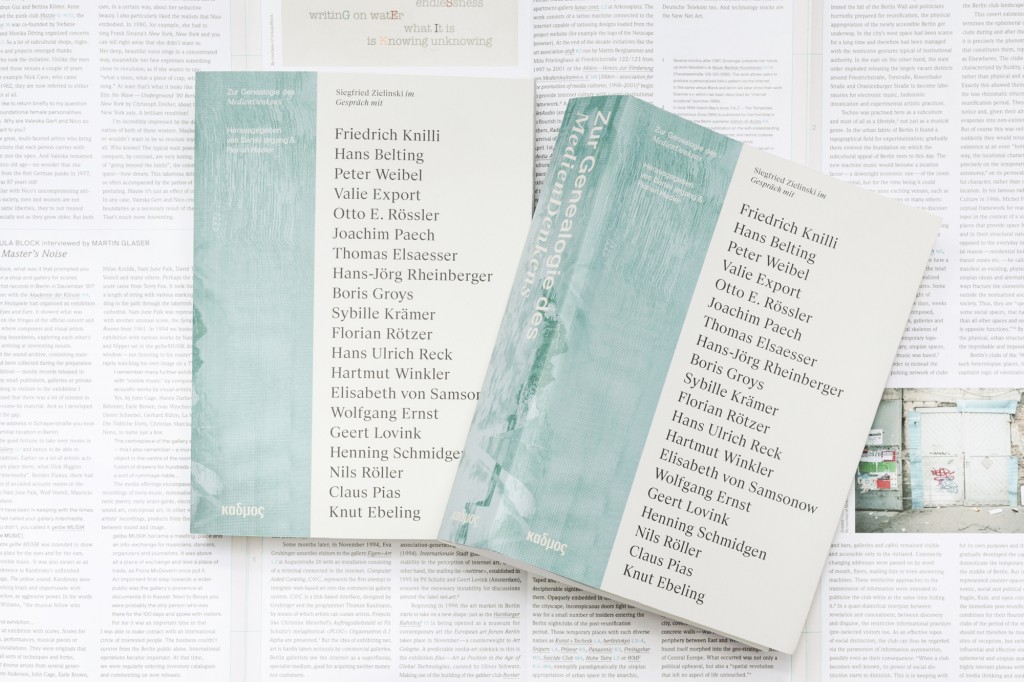
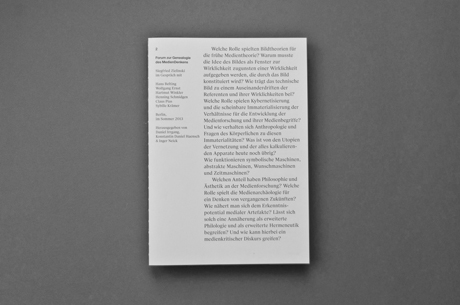
The second volume of the expanded documentation of the talks held within the Forum on the Genealogy of MediaThinking in summer term 2013 is now published by Verlag der Universität der Künste Berlin. Siegfried Zielinski in conversation with… Hans Belting, Wolfgang Ernst, Hartmut Winkler, Henning Schmidgen, Claus Pias and Sybille Krämer. It features contributions and material by Vilém Flusser, Florian Hadler, Konstantin Daniel Haensch, Toni Hildebrandt, Daniel Irrgang, Linnéa Meiners, Sandra Moskova, Inger Neick, Aneta Panek, Andreas Rauth, Sarah Johanna Theurer and Siegfried Zielinski. Edited by Daniel Irrgang, Konstantin Daniel Haensch & Inger Neick. The Forum on the Genealogy of MediaThinking – an essentially incomplete and open search for developments within the academic and artistic discourses about what media were, are and can be, drawn along the scientific biographies of Siegfried Zielinskis guests. It is an attempt to grasp in public talks, what has emerged as MediaThinking in universities and in the manifold current laboratories over the last decades. ISBN: 978-3-89462-260-2 The book is now available for sale at the UdK-library (foyer, Fasanenstraße 88, Berlin) for €15. It can also be ordered at Verlag der Universität der Künste Berlin (for an additional €2 shipping charges): Universität der Künste Berlin Universitätsbibliothek Publikationen Claudia Metz Einsteinufer 43–53 10587 Berlin Tel. (030) 3185-2157 Fax (030) 3185-2121 email publikat@udk-berlin.de 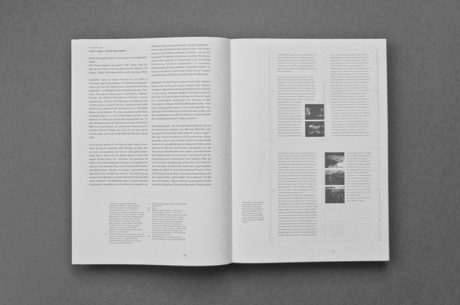
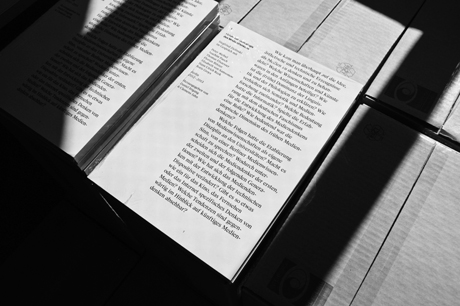

14.07.09 with Otto Rössler
Photo: © Thorben Stieler
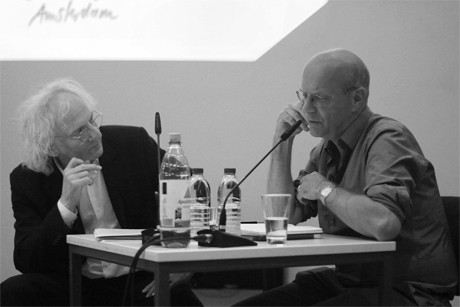
14.07.02 with Geert Lovink
Photo: © Thorben Stieler

14.05.08 with VALIE EXPORT
Photo: © Thorben Stieler
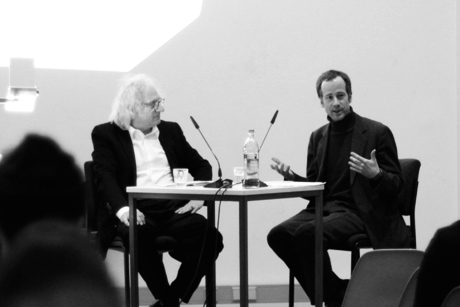
15.01.14 with Knut Ebeling
Photo: © Thorben Stieler

18.12.13 with Nils Röller
Photo: © Thorben Stieler
Knowing there is no way around it, i pose this rather inquisitive question right at the outset, not at least on behalf of my students: Your vita lists something that many might envy you for: 1993/94 – study of philosophy and aesthetics at Université Paris VIII. Michel Foucault and Felix Guattari had already been dead at that time. Gilles Deleuze died the year after your stay. May we ask you to give a short description of what these studies were like in Paris, twenty years ago? It occurs to me that the french master-thinkers of the past decades, who have in turn effectively influenced our thinking, conceive media rather in an implicit, as opposed to an explicit way (With the exception of the machine studies of Guattari and the explicit studies of cinema and painting by Deleuze). They are practitioners of what i call an implicit media thinking. In my understanding Knut Ebeling adopts this line of thought: his thinking of media is always an implicit, not necessarily an explicit one. Might that be beacuse it has long been unnecessary to specificly mention media in a philosophical or aesthetical context? Because media as explicit artifacts have long ceased to attract us? Or, to put it differently: In Knut Ebelings opinion – what are the lines of inquiry that still render direct mention of media or the media meaningful and interresting?
Knut Ebeling did not make light work of his dissertation regarding his choice of subject. It still isn’t a matter of course within the media studies discourse to work in depth on the french poet-philosopher Georges Bataille (let alone on his obscene works). Within our german phylum of thinkers this has lastly and passionately been done by Dietmar Kamper, who has consequently complimented your dissertation, which contains the two readings about Batailles “Madame Edwarda”, as the philological masterpiece of a “bladerunner”, a highly venturous act on a knife’s edge. The scope of our work here at UdK Berlin doesn’t permit us to penetrate in depth the intellectual micro-universe of Bataille. But we can at least discuss some of the questions that are – as i perceive it – incorporated in your fantastic book: The two readings which you suggest for this formally pornographic text with the most famous ellipses of recent literature history do implicitly lay ground for the concept of the poet-philosopher, which is – at least for the highest plateaus of thinking – the idea of irresolvable unity of poetry and philosophy. Might such a plea be one of the cornerstones of your project? To say it with a stronger reference to the scope of our own work here: One cannot think philosophy anymore without it’s modes of mediation, without taking into consideration the modalities of how it is expressed or performed (it’s medial representation). In Batailles philosophic-theologic-aesthetic cosmos Edwardas trap stands for god in all exclusiveness. Is the touch of the whores labia through the lips of the first-person narrator, experienced as scandalous even in the public of the brothel, a fierce (and at the same time shallow) plea for the sensuality of the body as potential for aesthetic experience? (Similar to Bunuels/Dalis cut through the eye in “Un Chien Andalou” from 1928, or Simones incorporation of the priests eye in Batailles “story of the eye”, likewise from 1928) Can Bataille serve as vade mecum against an all too vain “self-certitude and security of the idea”, as it is still practised by scholasticism? A philosophy outside the realm of sensual experience, which would also mean: without media, through which it is articulated? To the contrary: Do you recommend to read the poet-philosopher as an aesthetic theorist, as a philosopher of aesthetics? Let us stay with Bataille for a short while to bridge from him to another large thematic field, in which you are working intensely. In one of your texts on archaeology you identify Bataille to be an early protagonist of an archaeological practise in it’s figurative sense. Could one interpret the project of the “Documents” magazine, which he developed alongside other authors, as an archaeology of the present in times of the late 20s economic crisis and just before the great catastrophies? (And, in terms of design, as an adventurous layout of horizontal connections of text and images, of different categories of text, that was doomed to fail 80 years ago, but has long congealed into a convention nowadays?)
Without any doubt the archeological forms a vital dimension in Knut Ebelings media thinking. One might even say: For Knut Ebeling media studies is first and foremost a praxis within an “archaeology of the present” (in a benjaminian sense). The only difference being that his artifacts posess lesser distance to the “now”, than it was the case for Benjamin and his Arcades Project in relation to the 19th century (stadiums, iPhones etc.). Could one describe your intellectual approach as instant archaeology (the english term sounds a little better than the german “instantane Archaeologie”)? Perhaps it is better said from a spatial perspective: as an archaeology of proximity, of the things that approach our bodies? In the nice little book “Das Archiv brennt” (“the archive is burning”), which you have put together with Georges Didi-Hubermann, you state “not language is the home of being, the archive is the home of philosophy”, altering a famous phrase by Martin Heidegger. Like almost no other media theorist, Knut Ebeling has made efforts to sharpen the term of the “archive” in the context of the humanities and the arts over the course of the last few years, to work on the differentiation of its modes of usage, even to explicitly develop something like a critical archiveology. What is so fascinating to you personally about this “house” of contemporary philosophy? Do you link the archaeological method to a concrete hope “to find another access to the past” (a.a.O.:34), to pinpoint “escape routes from the prison that is history”, as you state in the first volume of “wild archaeologies” (“Wilde Archäologien”, p.732)? Or do you seek, in the sense of heideggerian formation of identity between origin and future, to develop open spaces for possible futures? Past and future as spaces of possibilities: “Archaeology and archives file the past, in order for it to befall us in the future”. (Wilde Archäologien / wild archaeologies, p. 731) And a few pages further into the book, even more to the point: “Because archaeologies mission is not the quest for old, but for new pasts and presents, it remained open – open for that project of ‘different archaeologies’ (Foucault), which are subject to Foucaults thinking towards the end of his archaeology of knowledge.” (p. 739) You keep stressing that archaeology as a discipline holds an important promise: to be able to couple natural sciences’ cool, and the humanities’ hot modes of thinking and methods. Does this contain the hope for an expanded hermeneutics? Or does it contain more of a long-term perspective of dissolution towards the objects of thought in natural science and their appliances, as it can be found in some of the less thorough readings of Friedrich Kittlers media theory? In the first volume of your “wild archaeologies” metaphoric disciplines like media archaeology are distinguished from the normal, tamed, classic archaeology by the fact that the former use the archaeological as a model for thinking, rather than as their program. The objects of a wild archaeology are not objects of utility, instead they are for instance the soul or the dream (as in Freud), the aesthetic sensitivities of the subject (Benjamin), knowledge (Foucault) or the media (as in Kittler). Thus, do the objects of a cultural- and media archaeological interest end up in the intermediate space between things of utility and things of thought, between metaphysics and physics…? And: would this be more of a precise or a soft ending? Your writings have helped me to better understand, amongst other things, one noticeable development. Not later than Michel Foucault “wild archaeologies” have turned into a possibility to practice materialism (in a narrow sense as the studies of “material culture”, see the WAs subtitle) without the dead weight of marxism or critical theory. Was it this development that rendered archaeology so attractive during the often hard-bitten battles in the late sixties and seventies? To finally be able to read Benjamin without the strait jacket of historical materialism? (sometimes elegantly achieved by Giorgio Agamben.) Here is an urgent question, that you possibly already discuss in the second volume of wild archaeologies: Given that the 20st century has been the age of diverse archaeologies, and thus has superseded the age of history (or better: historiography) – are there any speculations on the direction we are drifting in the 21st century? Do we fancy continuity again (put historiography for that) or can we take discontinuity to extremes any further?
Unfortunately unavailable to a broader audience, yet accessible for privileged readers as myself – at least for me it was a surprise to see George Bataille appear as reviewer of the historian and anthropologist Huizinga and his cultural theory as game theory in Knut Ebelings work. “An archaeology of homo ludens” whom has already pervaded so called postmodern cultural philosophy (for instance very prominently in Vilém Flussers work): Where does this interest stem from and how did the indeed spectacular discovery of Huizingas manuscript come about, followed by its discussion mainly through Batailles and Caillois? With regards to this labyrinthic topic we have to pace ourselves and focus on a few thoughts. I want to highlight two aspects, that might possibly be related: First: the opposition between labour and play that was particularly brought up by Georges Bataille relating to his ostracized economics (as opposed to Huizingas seriousness and play / Ernst und Spiel). In your epilogue you say “common economics is that perspective, that does not view the game from the perspective of beneficial labour, but that views the benefit from a perspective of the game and of exhaustion”, and with this as an outset you denote a “common economics of the child”: “the games purpose is more than just purpose (Zweck) and exhaustion (Verausgabung), more than accounting” (12). Does your studying of early cultural sciences and philosophic game theory react to an everyday situation, in which labour and game, seriousness and game are interlocked to such a degree, that their differences are beyond recognition? In your text on “Spiel/Zeug” you discuss contemporary communicational gadgets as in this sense hybrid artifacts between labour and spare time, or rest (Lust- und Frustmaschinen)… “The game is cultures dream”, this is one of your lovely terms in the epilogue of the M & S book (p. 15). Shortly before that you have introduced the arts as a playfield affiliated to the game (“on lifes sunday, man starts to play, by making art…” p. 13) – Is it the denotational closenes of game, eroticism and the arts, that is so fascinating about this topic? “because the game is only real insofar as it is without purpose (interesselos), as it contains its purpose within itself.” (Huizinga: lecture version) This question you have also posed already: Do parts of cultural and media studies still (or once again) work theirselfes into the ground about the “paradoxon” to “integrate the phenomena of unproductive exhaustion (Verausgabung) into an necessarily productive and meaningful (sinnstiftend) cultural theory” (K.E.), as it is already indicated in Batailles model of a self exhausting poetic practise? (Or, as Bruno Schulz put it, facing Gombrowicz: It is about making even the last remaining unhumanized fields available for the project of humanism…) A book that Knut Ebeling has compiled and edited in association with Kai Schiemenz has as it’s focus a special locality of the game as spectacle. There, in what could be described as an “archaeology of organized publics” / spectacles as architectures, you analyse competitive sports arenas, “stadiums” by means of an “artistic-scientific spatial research”. Are these attractors of event-mediation the last instances of mass media, or are they already emergences of a culture after the media? Have the large and expensive arenas, for which the global players amongst architecture offices carry out proper fights, superseded the major hollywood studios?
As a closure: Amongst the scene of media thinkers Knut Ebeling is one of the few who decided to teach and research within an art academy. In your view, what are the benefits of intellectual practise in such a context?
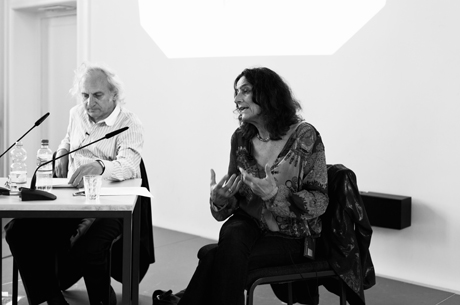
04.07.13 with Sybille Krämer
Photo: © Steve Bergmann
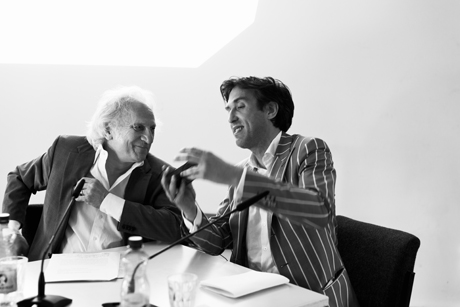
13.06.13 with Claus Pias
Photo: © Steve Bergmann
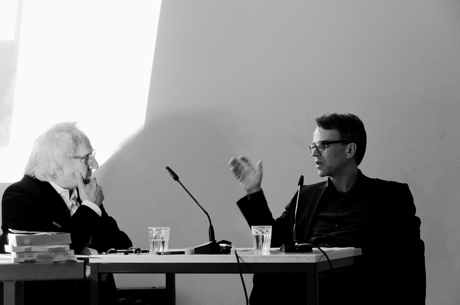
30.05.13 with Henning Schmidgen
Photo: © Robert Preusse
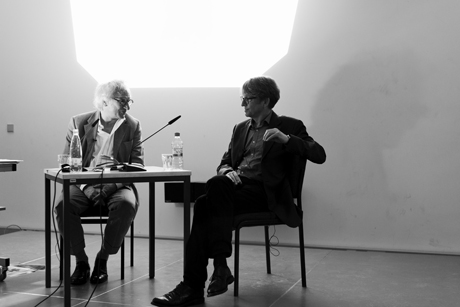
15.05.13 with Hartmut Winkler
Photo: © Steve Bergmann

02.05.13 with Wolfgang Ernst
Photo: © Leonard Jung
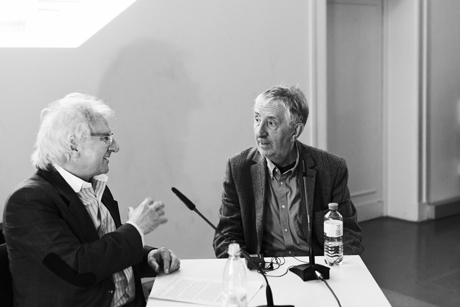
25.04.13 with Hans Belting
Photo: © Steve Bergmann
Allow me to begin with an inquisitive and always urging question, which only philosophers can answer proficiently: throughout this series of panels we are deliberately working with an open operational concept of mediaThinking so that heterogenous media theoretical positions can have a say. During the previous century the most diverse concepts of media were invented and sharpened. Do we need one homogenous concept in your opinion, could such a concept even persist? Or is the coexistence and intertwining of competing concepts more appropriate for a field of research focussing on communications based upon or mediated through technology to be activated according to epistemological interests? Let us – along the lines of your work biography – proceed more systematically to the problems which drew (or dragged?) the philosopher Sybille Krämer into the discourse on the complex interrelations between culture, thought and technology. Is it possible for your doctorate thesis entitled Technik, Gesellschaft und Natur. Versuch über ihren Zusammenhang (1982, Technology, Society and Nature. Attempt on their relationship) to be interpreted as an attempt to develop a concept along the lines of a systematic social theory of technology? The leading perspective seems to be the derivation of technology from a “substantial mean-ends relationship” (“stofflichen Zweck-Mittel-Relation”), coming from a context of work and appropriation of nature. Besides epistemological issues knowledge from technical and industrial sociology and even engineering comes into effect at the same time. How could this rather odd mixture for a philosopher emerge at that time, which I would much rather associated with Günther Ropohl’s Systemtheorie der Technik (1979, System Theory of Technology), Werner Rammert’s sociological technology studies or Karin Hausen’s early accounts on the history of technology (e. g. The Social History of the Sewing Machine), whom I encountered during my studies at the Technical University of Berlin? Which were the references in philosophy for your early reflections on technology? Did the early cultural studies (Hoggart, Williams) play a significant role, with their discovery of the materiality of communications, or even the new psychoanalytically coined machine concepts from France? There is another less known yet more practical work related contextualisation for this field of research: from 1984 Sybille Krämer was part of the work group “Human beings and technology” (“Mensch und Technik”) as well as the commission “Artificial intelligence” at the Verein Deutscher Ingenieure (VDI, Society of German Engineers) in Düsseldorf. Which meaning did this cooperation have for the development of your specific concepts of technology (Technik und Technologie)? In 1988 your book entitled Symbolische Maschinen. Die Idee der Formalisierung in geschichtlichem Abriss (Symbolic machines. A historical abstract on the concept of formalisation) came out, to be followed three years later by your habilitation treatise Berechenbare Vernunft. Kalkül und Rationalismus im 17. Jahrhundert (1991, Computable reason. Calculation and rationalism in the 17th century). Heidegger still specified his understanding of technology along the lines of mechanical objects such as a hammer or a windmill. At the heart of your two books lies the insight that everything, which can be expressed through a law can eventually be mechanised, as Turing put it in the 1940s oder Mortimer Taube in the early 1960s – on the mediation part of formalisation, which e. g. can consist of an algorithm. Am I right in interpreting your books to be much less a contribution to the history of technology or aparatuses, but much more a contributions to the history of ideas of computation – and thus to that particular way of thinking, which precedes the computer as a concrete artefact and technological system in the very literal sense? What is epistemically concealed behind the idea to pay more attention to an activity (computation/formalisation) than to a piece of technology? Is it possible to read the Symbolic machines and the Computable reason from this perspective as fundamental contributions to the mediality of the computer, before the actual concept if the mediality in the context of your metaphysics has even been developed? In a legendary publication from 1989 on the archaeology of media, Norbert Bolz, at that time assistant in hermeneutics at the Institute for Philosophy at the FU (the time of Taubes and Hübener), writes his entrée into the media discourse with a discussion of McLuhan’s Understanding Media, which had been released a quarter of a century earlier. (Interestingly with paragraph-long quotations of the American text while a German translation had been around since 1968.) In the same book Dietmar Kamper writes one of his cultural anthropological provocations entitled: “Sturz der Bilder in die Zeit” (“Demise of the images into time”): “not from the margins, but from amidst the reach of power of modernity emerges a certain time machine, that swallows images, instead of revealing them any longer.” („Nicht vom Rande her, sondern inmitten des Machtbereichs der Moderne tauchte eine gewisse Zeit-Maschine auf, die Bilder verschluckt, statt sie weiterhin zum Vorschein zu bringen.“, Ibid., p. 143) – 1989: the year when Sybille Krämer takes up her professorship at the FU Berlin. How present were the traces of the third generation of German mediaThinkers at the philosophy department of the Free University at that time? What kind of intellectual and theoretical milieu did you encounter there, to challenge or advance your epistemological interest? Did your relationship to Wilhem Schmidt-Biggemann, Mr. Ars Combinatoria as we used to call him, turn out to be complementary? (Since at least with regards to the Early Modern Age your fields of research partially overlapped.)
Which brings us to the second focus of my questioning: What are the intentions behind Sybille Krämer’s Metaphysics of Media (Metaphysik der Medien)? What is the concept aiming for? Which established discourses is the concept of the messenger or that of transmission trying to critically interfere with and what characterises its originality, not least in distinction from e. g. Michel Serres’ 1968 five volume anthropology of communications published in Paris named after Hermès, the messenger of the gods? Let us begin with the subject of critique to be found superficially in McLuhanism which has probably been identified much better throughout the media archaeology of Friedrich Kittler and some of his students. Against the technological a priori, shaping or even determining every medial process, Sybille Krämer focusses once again on that which processes in-between the medial and on how mediation takes place as transformation (Übertragung). Would you agree with this description of the tensions unfolding in your book from 2008? The point where spirits in media theory significantly part is nothing less but the concept of media itself. In your 1998 contribution to Media, computer, reality (Medien, Computer, Realität) you clearly put your concept on the table: “We do not hear vibrations of air but the sound of a bell, we do not read letters but a story […]“. The medium tends to be invisible/inaudible. Only through noise or a film tear it obtains validity. What is the epistemological core of the concept of a “transparent medium”? What is the concept of an immediately experienced mediacy (2008, p. 103) useful for? Another question imposing itself on us in the context of our work together with the arts: which kinds of medial processes does your theory focus on? Ideal every-day communications, that are technologically mediated (which used to be called mass media)? Since the first European avantgarde about 100 years ago, artists have been deliberately working with the anti-Aristotelian concept of inextricably linking the medium and the message with each other making and keeping the medialised world, being a technologically produced world, experienceable beyond strategies and tactics of the destruction of the material. Which has been adapted throughout TV shows, interface design and advertising. What is the use of the construction of a medium which one principally does not recognise, which allows frictionless immersion? Your heuristics of the messenger, whom the message is not (yet) separated from, keeps insisting on the messenger’s corporeality (Körperlichkeit) (the absence of which you regret throughout Kittler’s writing despite his pleas of physical hardware). It has been attempted several times to write the genealogy of telematic media as a process of the successful separation of the message from the body of the messenger. Does Sybille Krämer’s metaphysics put something back into play which seems to have already evaporated under the condition of electronic and digital communications? What is the meaning of your peculiar concept of the trace in this context (as opposed to the symbolic “conventionalised sign”)? Does it contain an offer for perception (aisthesis) within the medial process? “With mediality“, as you put it in your little metaphysics, “we do not mean distinguishable media such as sound, text, image, but a description and line of interpretation of our human form of life and culturally shaped world which aims for an elementary dimension.” (2008, p. 103, „Mit Medialität meinen wir nicht voneinander abgrenzbare Medien wie etwa Ton, Text, Bild, sondern eine auf eine elementare Dimension zielende Beschreibungs- und Deutungsperspektive unserer menschlichen Lebensform und kulturell geprägten Welt.“) Does this imply a return to anthropological problems? Some of the texts connected with this idea were published in Paragrana, the in-house periodical of the department for Historical Anthropology at the Freie Universität Berlin- Is your research on the voice and its floating existence “between reason and power, between seduction and concept” (Negative Semiologie der Stimme, 2003, p. 77, „zwischen Ratio und Macht, zwischen Verführung und Begriff“) to be read along the same trajectory? Here, too, your focus seems to lie on that which articulates itself in speech act beyond that, which can be ordered according to symbolic rules and which permeates through the mask of the person (per-sonare) in the tension between the Dionysian and the Apollonian…
Piercing the heart of the human being/machine relationship, especially within a design and art context, a distinction can be found throughout your writing since at least 15 years: between the instrument (as mediator for a particular use) and medium (as mediator of something). Technology as a tool follows a clear function, it saves work; whereas technology as an apparatus should be understood as a machine generating world – is how one could attempt to reconstruct correspondingly from your texts from the 1990s. Does this distinction between instrumental and medial use account for the “trans-classic machine” (Bense) as well, the “abstract machine” (Chomsky)? Or has the tool-medium dualism invaded the inner life of telematically networked computers, unfolding as a normal tension in various dimensions? “The branch of mathematics, which uses diagrams, isn’t called formal but intuitive, or at least is attributed certain intuitive elements”, Mortimer Taube accounts in his legendary text on the Myth of Thinking Machines from 1961 (quoted and translated from the German edition, 1966, p.13, „Den Zweig der Mathematik, der Diagramme verwendet, bezeichnet man nicht als formal, sondern als intuitiv, oder man schreibt ihm zumindest gewisse intui-tive Elemente zu“). The diagrammatic, which you have been concerning yourself with throughout the last years, seems to be located between the tool (for thinking) and your concept of mediality, which generates, leaves and transfers traces. That, which you call “operative imagery” (“operative Bildlichkeit”) deals on one hand with those schematic “mediators between thing and concept, the particular and the general” (“Mittler zwischen Ding und Begriff, Einzelheit und Allgemeinheit “), as has been thought and done with diagrams in ancient cultures. On the other hand, Sybille Krämer aims to rediscover and to reactivate the schematism and the scheme, the monogram respectively, in Kant’s Critique of pure reason and of Judgement. “…schematism is a procedure of imagination” („Logik des Bildlichen“, 2009, 109, “[…] der Schematismus ist ein Verfahren der Einbildungskraft“). The “figurative Synthesis”, which can be expressed through schemes, obviously has special importance to you as an activity? What is so special about this kind of imagination which can be transformed from a synthetisation of the manifold (past) into a schematisation of the future possible? How close is this conception of imagination, which can be articulated diagrammatically amongst others, to Kantian philosophy and how distant is it from Heidegger’s metaphysics-critique of Kant? Two questions in the end, which have been discussed earlier in the seminar: John Durham Peters’ deep time study of communications plays a surprisingly fundamental role in the development of your Metaphysics of mediality (Metaphysik der Medialität). He is one of the few intellectuals, who does not automatically apply a halo of the emancipatory to communications. What is it that fascinates you about this concept, which might have been put most pointedly in Guy Debord’s art loving philosophy: telecommunication connects, but it can only connect that which has already been disconnected. My final question is referring to the so called “speculative realists”, who interestingly claim to develop a new metaphysics, too. We travelled through Brazil with one of them. Graham Harman also refers to McLuhan critically insinuating that he (just like Heidegger) did not attribute any meaning to the content of a medium, opposite to its “deep and invisible ground”. (A hypothesis which I personally find very questionable.) From a media philosophy allegedly adverted to contents he deducts his plea for a return to a phenomenology of the real, for an attention to the material or, as Vilém Flusser would have put it: to an appraisal of the superficial. Are these challenges at all for a contemporary German philosopher, who is interested in mediality?
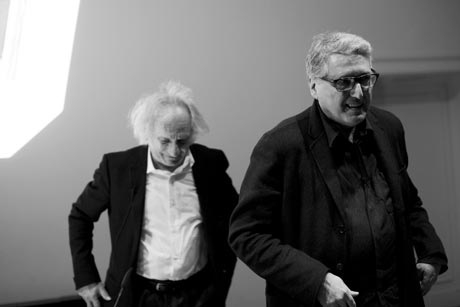
13.02.2013 with Prof. Dr. Boris Groys
Photo: © Steve Bergmann
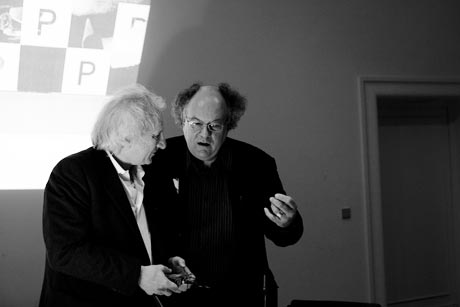
30.01.2013 with Prof. Dr. Hans Ulrich Reck
Photo: © Steve Bergmann
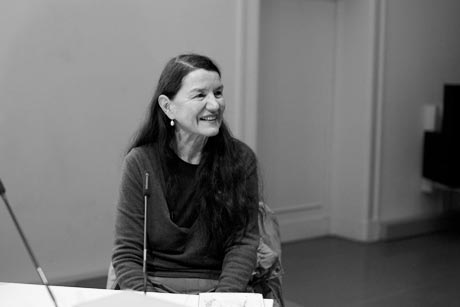
16.01.2013 with Prof. Dr. Elisabeth von Samsonow
Photo: © Steve Bergmann
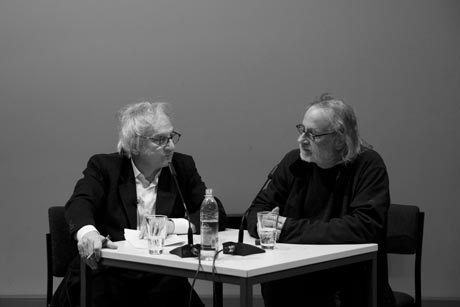
05.12.2012 with Florian Rötzer
Photo: © Clemens Jahn
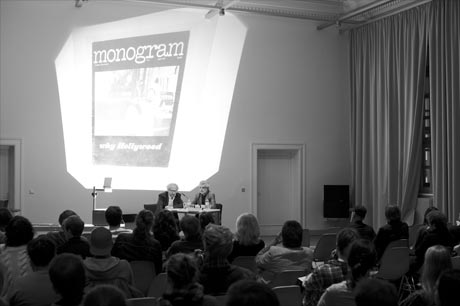
21.11.2012 with Prof. Dr. Thomas Elsaesser
Photo: © Steve Bergmann
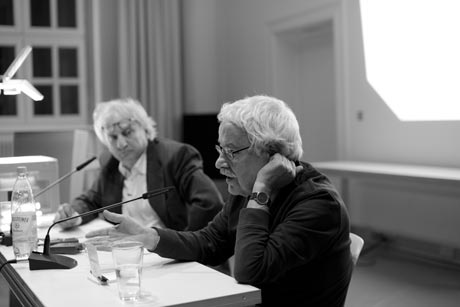
07.11.2012 with Prof. Dr. Joachim Paech
Photo: © Steve Bergmann
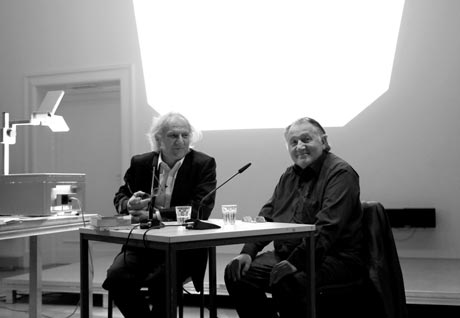
24.10.2012 with Prof. Dr. Peter Weibel
Photo: © MONOKROM
The »Forum on the Genealogy of MediaThinking« is a series of events hosted by Prof. Dr. Siegfried Zielinski at the University of the Arts Berlin, department for media theory (focus »Variantology / Archaeology of Media«) in collaboration with Daniel Irrgang and Clemens Jahn. Selected protagonists are introduced in a series of panels, which take place every two weeks. Subsequently an evaluation of the talks will be published. The talks are open to the public and take place at the auditorium of the UdK Berlin Medienhaus. How did the idea to think and treat aesthetic products as media emerge? Which sciences and arts were involved in the beginning? How is the (early) dominance of linguists and philologists to be explained? How did semiotics and media studies act towards each other? Which meaning did informatics have? Which role did the experience of German fascism play in the development of media thinking? How meaningful was the utopian dimension of early media thinking? Which were the consequences of the establishment of media studies as an independent discipline at universities? Does it make sense, to talk about a »Berlin school of media studies«? How do the first, second and third generation of media thinkers differ from one another? How did mediaThinking change with the development of technological dispositifs? Is there a specific mode of thought for the cinema, television or the internet? Which tendencies are currently to be foreseen regarding a future mediaThinking? These are just a few of the questions to be asked in the »Forum on the Genealogy of MediaThinking«. Further questions will emerge and be developed by the participants during the course of our experimental research. The genealogy of media thinking – in Europe and the whole world – is a desideratum. This seminar aims to write nothing less but a small genealogy of this peculiar way of thinking and designing culture. Interdisciplinarity has been part of which since the beginning. Naturally we act accordingly.
“Like heaven and hell, the Internet knows no locality. Body and mind together, on the other hand, can only be present in one place. To prevent further sacralization of the internet, it is useful to develop a profane relationship to them. This can only be done from a place that is outside the networks. Localities have a different quality of public than marketplaces, concert halls, or stadiums.”
(Zielinski, [... After the Media] – News from the Slowly Outfading 20th Century
(Univocal/Minnesota University Press, 2013)
*
***
On the Energies of Dreaming (Forward)
Interview with Dominic Smith, University of Dundee, 2025
https://energy-philosophy.ac.uk/siegfried-zielinski-on-the-energies-of-dreaming/
*
***
https://www.pagina12.com.ar/856223-una-vela-encendida-en-las-pantallas-del-mundo
*
***
*
https://open.spotify.com/episode/4mOJrlDUQL9w1UY06ZQQxh
Lukas Feireiss and Florian Hadler in conversation with Siegfried Zielinski
“über Anarchäologien, Zeitmaschinen und Extelligenzen” (deutsch).
***
*
Errki Huhtamo shot these fotos in February 1991 in Turku/Finland during an early conference on MEDIA ARCHAEOLOGY. Also participating in the conference: cinema historian THOMAS ELSAESSER and filmmaker WERNER NEKES.
*
***
In Werner Nekes’ Wunderkammer – one of our last conversations about the deep time of technical images, our diverse an-archaeologies of media and the delights and hardships of passionate collecting. Photo (Copyright): MONO KROM, 2014
*
***
*
Friedrich Knilli, charismatic pioneer of critical media research in Germany and founder of the first academic course for media studies at a German university died on February 1, 2022, just a few days before his 92nd birthday, in Berlin.
Siegfried Zielinski zum Tod des Medientheoretikers Friedrich Knilli (deutschlandfunk.de)
***
Radio Kebab
„”We feel as if we are locked in a vacuum, no reaction to our screaming and whispering, our dancing and our music, no echo…….. Dryly our voices bounce off the concrete walls.” – “Wir kommen uns vor als seien wir in ein Vakuum gesperrt, keine Reaktion auf unser Schreien und Flüstern, unsere Tänze und unsere Musik, kein Echo……. Trocken prallen unsere Stimmen von den Betonwänden ab.“ (Radio Kebab was a pirate radio station in Westberlin, distr. Rhizom bookshop, appr. 1980)
***
https://www.rcin.org.pl/dlibra/publication/79482/edition/59835/content?ref=struct
Interview mit Konstantin Sydlowski
“Arqueología prospectiva”
Article in Spanish language in
H-ART. Revista de historia, teoría y crítica de arte
University Los Andes, Bogota, Columbia,
with an introduction by Andrès Burbano:
“Passing the future through the eye of a needle”
https://revistas.uniandes.edu.co/toc/hart/8
*****
“Heiße Spulen im Seminarraum” and
“Schokolade für einen guten Schnitt”
Two Video-Interviews (in German) with ArneKaiser / Generation Testbild
on the Archaeology of Videorecording:
https://www.youtube.com/watch?v=HoXYap2aLAY
https://www.youtube.com/watch?v=nSrNkVaZpPk&feature=youtu.be
*****
Conference near Sofia 1992 (left: Rossen Milew, right: Siegfried Zielinski)
with participants from Albania, Bulgaria, France, Greece, Macedonia, Russia, Hungaria and other countries
*****
PAN Ji, LI Lingyan:
Media Research, Technological Innovation and Knowledge Production:
Insights from Media Archeology—
A Conversation with Professor Siegrfied Zielinski
Published in: Chinese Journal of Journalism & Communication, July 2020
*****
Friedrich Knilli, founder of academic media studies in Berlin, is 90! – (only in German)
*****
Bibliography on Thinking Media
***
Excerpts from the conference program
with Thomas Elsaesser in Beijing, Dec 2019:
北京大学“黉门对话”专家主题论坛
媒介考古:艺术、媒介与感知
Media Archaeology: Art, Media and Perception
议程
Time: Dec. 2-3, 2019
Venue: Yingjie Overseas Exchange Center, Peking University
Convener: Hongfeng Tang (Researcher, School of Arts, Peking University)
Agenda
Dec. 2, 2019
Venue: Moonlight Hall, Yingjie Overseas Exchange Center Host: Hongfeng Tang
I. Opening Ceremony (8:40-9:00)
1. Hongfeng Tang:
Introduction of Conference Theme
2. Feng Peng (Professor and Dean of School of Arts, Peking University) Welcome Speech
II. Keynote Speech (9:00-12:00)
1. Siegfried Zielinski (Professor for Archaeology & Variantology of the Arts & Media at Berlin University of Arts (i.r.) Michel-Foucault-Professor at EGS Saas Fee (CH))(9:00-10:30)
Prospective Archaeologies – Travelling through DEEP TIME OF THE MEDIA – from the Past into the Future
2. Screening (10:45-11:45)
Siegfried Zielinski: Returning to the Future
One Hundred — Twenty Short Films on the Archaeology of Audiovision
3. Q & A (11:45-12:15)
III. Keynote Speech (13:30-15:00)
Thomas Elsaesser (Professor Emeritus, University of Amsterdam) (13:30-15:00)
Film History as Media Archaeology
IV. Conversation (15:10-17:40)
1. Convesation between Prof. Zielinski and Prof. Elsaesser (15:10-16:10)
2. Discussions and Responses (16:10-17:10)
Feng Peng, Huimin Jin, Weixng Chen, Yang Li, Bingfeng Dong (Researcher, School of Intermedia Art, China Academy of Art), Hongzhe Wang, Chang Shi, Yaping Xu
3. Q & A (17:10-17:40)
***
Siegfried Zielinski – Against psychopathia medialis — For normal schizophrenia (Spanish Translation, Trans. Giancarlo Sandoval
*****
KAABA by Aidan Salakhova in the virtual Museum of collector Lutz Teutloff:
https://vimeo.com/143768216
Teutloff Museum’s virtual exhibition of Aidan Salakhova’s video installation ‘Kaaba’, with additional pilosophical comments by Prof. Dr. Siegfried Zielinski ( professor of media theory at the Berlin University of the Arts and member of the Academy of Arts in Berlin), who has a Christian background.
How do you assess the role of Muslim women in Islam?
Neither Christianity nor Islam define a standardised apportionment of roles for women. Word-based religions are interpretations of master-texts, of a Holy Sripture. In Christianity it’s the Bible and in Islam it’s the Qur’an.
Since Muhammad’s time different images of women have been created and established. Today many different ideas compete for women’s favours, which I welcome. The most beautiful and most powerful identities have a message to win.
Is it possible to reform this role internally?
There is no ‘Internal’ in a globalized network. Today and in the future no one can act in complete isolation.
The inner and the outer world of states or religions are inextricably linked. Islam, like Christianity are urgently in need of change. Future is our space of possibilities, we should all be getting actively involved in.
How could this reform be taking place?
Open dialogues are the ways to improve future of religions, anything else will fail. A good dialogue requires participants who can convince with confidence with will to listen. Dialogue and violence are mutually exclusive terms.
download (PDF / 14mb)
J.R. Pierce, Portrait of the Machine as a Young Artist, in: Hugh M. Hefner, A. C. Spectorsky and Jack J. Kessie, Playboy (Chicago, June 1965)
Download (PDF / 8.1Mb)
Otto Rössler, Mikrokonstruktivismus, in: Hans Ulrich Reck, Siegfried Zielinski, Nils Röller and Wolfgang Ernst, Lab. Jahrbuch 1995/96 für Künste und Apparate (Köln, 1996)
Download (PDF / 4,4Mb)
Geert Lovink, From Speculative Media Theory To Net Criticism. , in: nettime mailing (1997)
Download (PDF / 7,1Mb)
Siegfried Zielinski, Technology and Ideology, Projektkurs TU-Berlin (October 1980).
Download (PDF / 8.2Mb)
Nils Röller, Vilém Flusser – Kinotheorie in der ‘Bubertät’, in: Schnitt 24 (Köln, 2001)
Download (PDF / 1.1Mb)
Nils Röller, Die Möglichkeiten des Dia, in: Stéphane Bauer and Katharina Hohmann (Ed.), Dia/Slide/Transparency (Berlin, 2000), p 13–18
Download (PDF / 33Kb)
Nils Röller, Geld, Zwang, Instrumente – Moby Dick als Paradigma, in: Wilfried Dickhoff and Marcus Steinwegr (Ed.), INAESTHETICS 3 (Berlin, 2012)
Download (PDF / 180Kb)
Nils Röller, Prometheus – Instrumente hören und denken, in: Hans-Georg von Arburg and Sergej Rickenbacher (Ed.), Concordia discors. Ästhetiken der Stimmung zwischen Literaturen, Künsten und Wissenschaften (Würzburg, 2012)
Download (PDF / 20Kb)
Nils Röller, Figur und Instrument, in: Julia Draganovic, Nils Röller, Sabine M Schmidt and Tim Zulauf, Yves Netzhammer (Ostfildern, 2008), p 174-178
Download (PDF / 1.02Mb)
Knut Ebeling, Das technische Apriori, in: Lorenz Engell, Bernhard Siegert and Joseph Vogl (ed.), Kulturgeschichte als Mediengeschichte (oder vice versa?) (Weimar, 2006): 11–22
Download (PDF / 15Mb)
Florian Rötzer, Suspendierte Zukunft, in: werk und zeit (4/1987), p. 3–5
Download (PDF / 24,4Mb)
Ernst Schmidt and Peter Weibel, Revision in Sachen Wertov, in: Ed. Erhard Friedrich Verlag: film (Velber bei Hannover, February 1968): 16-19
Download (PDF / 5.8Mb)
Siegfried Zielinski, Dialektik der Unterhaltung, project draft, TU-Berlin (March 1983)
Download (PDF / 7.4Mb)
Cover and table of contents from Projekt Technik & Massenmedien, Medienwissenschaft TU Berlin, 1982, ed. by Siegfried Zielinski
Download (PDF / 572Kb)
Sybille Krämer, Technik als Kulturtechnik. Kleines Plädoyer für eine kulturanthropologische Erweiterung des Technikkonzepts, in: Klaus Kornwachs (Hg.), Technik – System – Verantwortung (Münster, 2004), p. 157–164
Download (PDF / 761Kb)
Sybille Krämer, Der Bote als Topos oder: Übertragung als eine medientheoretische Grundkonstellation, in: Till A. Heilmann, Anne von der Heiden & Anna Tuschling (Hrsg.), medias in res. Medienkulturwissenschaftliche Positionen (Bielefeld, 2011), p. 53–67.
Download (PDF / 1.6Mb)
Sybille Krämer, Operative Bildlichkeit. Von der ‚Grammatologie‘ zu einer ‚Diagrammatologie‘? Reflexionen über erkennendes ‚Sehen‘, in: Martina Hessler und Dieter Mersch (Hrsg.), Logik des Bildlichen. Zur Kritik der ikonischen Vernunft (Bielefeld, 2009), p. 94–122.
Download (PDF / 1.3Mb)
Gabriele Bock and Siegfried Zielinski, Britain’s Channel 4: A TV provider caught between private sector funding and its cultural mission, trans. by Corina Holzherr, in: “Media Perspektiven” (1/1987), p. 38–54.
Website of the Channel 4 research project at the University of Portsmouth
Download (PDF / 19.7Mb)
Siegfried Zielinski, Nomadentum und Disziplinlosigkeit. Zur Identität von Medien-Wissenschaftlern im Transit, in: agenda. Zeitschrift für Medien, Bildung, Kultur (Bonn, July / August 1993), p. 44–46
Download (PDF / 1.1Mb)
Claus Pias, On the Epistemology of Computer Simulation, Zeitschrift für Medien- und Kulturforschung (Number 1, Hamburg 2011), pp. 29–54
Download (PDF / 3.7Mb)
Claus Pias, One-Man Think Tank. Herman Kahn, oder wie man das Undenkbare denkt, Zeitschrift für Ideengeschichte, (Marbach am Neckar, Fall 2009), pp. 5–16
Download (PDF / 4.1Mb)
Claus Pias, ›Bat men begin‹.Die Fledermaus und die Erfindung der Abschreckung, in: Anne von der Heiden und Joseph Vogl (Ed.), Politische Zoologie (Zürich / Berlin 2007), p. 305–316
Download (PDF / 541Kb)
Henning Schmidgen, Die vielsagende Stummheit der Geräte, in: ZKM Karlsruhe, Maschinensehen. Feldforschung in den Räumen bildgebender Technologien (Karlsruhe 2013), p. 39–49
Download (PDF / 266Kb)
Henning Schmidgen, Das Konzert der Maschinen. Simondons politisches Programm, in: Lorenz Engell and Bernhard Siegert (ed.), Zeitschrift für Medien- und Kulturforschung 2 / 2012 (Hamburg 2012), p. 117–134
Download (PDF / 745Kb)
Henning Schmidgen, 1900 – The Spectatorium: On Biology’s Audiovisual Archive, in: Grey Room 43 (Cambridge, MA 2011), p. 42–65
Download (PDF / 320Kb)
Hartmut Winkler, Strange Attraction 1975, in: Doris Rosenstein und Anja Kreutz (ed.), Begegnungen. Facetten eines Jahrhunderts (Siegen 1997), p. 234–236
Download (PDF / 213Kb)
Hartmut Winkler, Viefs Hase. Medien, Verräumlichung und Reversibilität, lecture for the conference: Media Theory on the Move, Potsdam, May 21–24, 2009
Download (PDF / 303Kb)
Hartmut Winkler, Prozessieren. Die dritte, vernachlässigte Medienfunktion, lecture at the conference: Media Theory in North America and German-Speaking Europe, University of British Columbia, Vancouver, April 8–10, 2010
Download (PDF / 708Kb)
Hartmut Winkler, „Speichern, Verdichten“, in: id., Diskursökonomie. Versuch über die innere Ökonomie der Medien (Frankfurt a. M. 2004), p. 110–130
Download (PDF / 859Kb)
Hartmut Winkler, preface and „Symbolischer Charakter“, in: id., Basiswissen Medien (Frankfurt a. M. 2008), p. 1–20 & 61–87
Download (PDF / 30Kb)
Wolfgang Ernst, preface to Gleichursprünglichkeit. Zeitwesen und Zeitgegebenheit technischer Medien (Berlin 2013)
Download (PDF / 170Kb)
Wolfgang Ernst, Epistemologie des Sonischen, Medienarchäologie des Akustischen und Zeitwe(i)sen der Musik, lecture for the education and research project Resonanzräume: Medienkulturen des Akustischen at the Heinrich-Heine-Universität Düsseldorf, Salon des Artistes, May 10th, 2012
Download (PDF / 513Kb)
Wolfgang Ernst, Medienwissen(schaft) zeitkritisch. Ein Programm aus der Sophienstraße, Wolfgang Ernst’s inaugural lecture at Humboldt-Universität zu Berlin on Oktober 21st, 2003
Download (PDF / 8.5Mb)
Siegfried Zielinski, Holocaust. Auschwitz als Fernsehfiktion in deutschen Wohnzimmern, in: Unsere Medien – Unsere Republik. No. 7, Mediengeschichte als Geschichte der Bundesrepublik, ed. by Adolf-Grimme-Institut des Deutschen Volkshochschul-Verbandes e. V. (Marl, November 1990), p. 33ff.
Download (PDF / 112Kb)
Siegfried Zielinski, Audiovisuelle Zeitmaschine. Schlußthesen zur Kulturtechnik des Videorecorders, from: Id., Zur Geschichte des Videorecorders [1986] (Potsdam 2010), p. 431–437
Download (PDF / 310Kb)
Hans Ulrich Reck, Kunstzeit/ Medienzeit. Betrachtungen über Medien, Rausch, Verschwendung und eine Poetik des glückhaften Moments, in: Ed. Thomas Hensel, Hans Ulrich Reck und Siegfried Zielinski, Goodbye, Dear Pigeons. Lab – Jahrbuch 2002 für Künste und Apparate (Köln 2002)
Download (PDF / 115Kb)
Hans Ulrich Reck, Aby Warburg als Medientheoretiker? Aus Anlass und zur Edition von Band 1 der ‘Gesammelten Schriften’, in: Kunstforum International, Bd. 152 Dezember (Köln 2000)
Download (PDF / 123Kb)
Hans Ulrich Reck, Surrealismus als Überlebenstraining – Varian Fry zu Ehren, bisher unpubliziert, geschrieben Dezember 2007
Download (PDF / 149Kb)
Hans Ulrich Reck, Archive, Inszenierungen, Einschnitte, Verzweigungen. Sammeln im Zeitalter digitaler elektronischer Medien, in: Ed. Gerda Breuer, summa summarum. Sammeln heute (Basel/ Frankfurt 1999)
Watch on Vimeo
Friedrich Kittler, Gute Maschinen und böse Maschinen, Themenwoche KHM 1997, mit Siegfried Zielinski und Wolfgang Ernst
LLUREX VIDEO Egon Bunne, KHM 1997
Download (PDF / 85Kb)
Elisabeth von Samsonow, Transplant Photosynthesizer’s Crescendo, Lecture / Performance at the brut Künstlerhaus (Vienna, December 15th 2012)
Download (PDF / 156Kb)
Elisabeth von Samsonow, Genitum – non factum. Die Ursachen der Geburtsvergessenheit, in: Ed. Christoph Wulf, Anja Hänsch, Micha Brumlik, Das Imaginäre der Geburt. Praktiken, Narrationen und Bilder (München 1998): 188–198
Download (JPG / 946Kb)
Poster – Colloquium on schizo culture in 1975 at Columbia University, New York, sponsored by Semiotext(e). With guests such as Jean-François Lyotard, Michel Foucault, Gilles Deleuze, Félix Guattari, William Burroughs, John Cage et al.
Download (PDF / 2.3Mb)
Elisabeth von Samsonow, Die Hehler des Sinns. Zum Verhältnis von Kabbala und Secret Service, in: Ed. Aleida Assmann & Jan Assmann, Geheimnis und Öffentlichkeit (= Schleier und Schwelle) Band 1 (München 1997): 281–290
Download (PDF / 84Kb)
Florian Rötzer, Wahrheit oder Stimulans? (1993)
Download (PDF / 67Kb)
Florian Rötzer, Analog-Digital (1992)
Download (PDF / 18.6Mb)
Florian Rötzer, Im Sog der turbulenten Leere. Bemerkungen zur dekonstruktivistischen Ästhetik, in Kunstforum Bd. 108 Jun / Jul 1990 (Ruppichteroth 1990): 184–209
Download (PDF / 30.9Mb)
Ed. Florian Rötzer, Kunstforum Bd. 98 Jan / Feb 1989. Ästhetik des Immateriellen? Das Verhältnis von Kunst und neuen Technologien. Teil II (Ruppichteroth 1989): 52–75, 100–105, 108–117
Link to the Article
Siegfried Zielinski, Gegenwartseffekte: Nach „Ich denke, also bin ich“ kommt „You tube – therefore you are“, in: Berliner Gazette [http://berlinergazette.de/you-tube-therefore-you-are/, (last access: Dec 1st 2012)]

